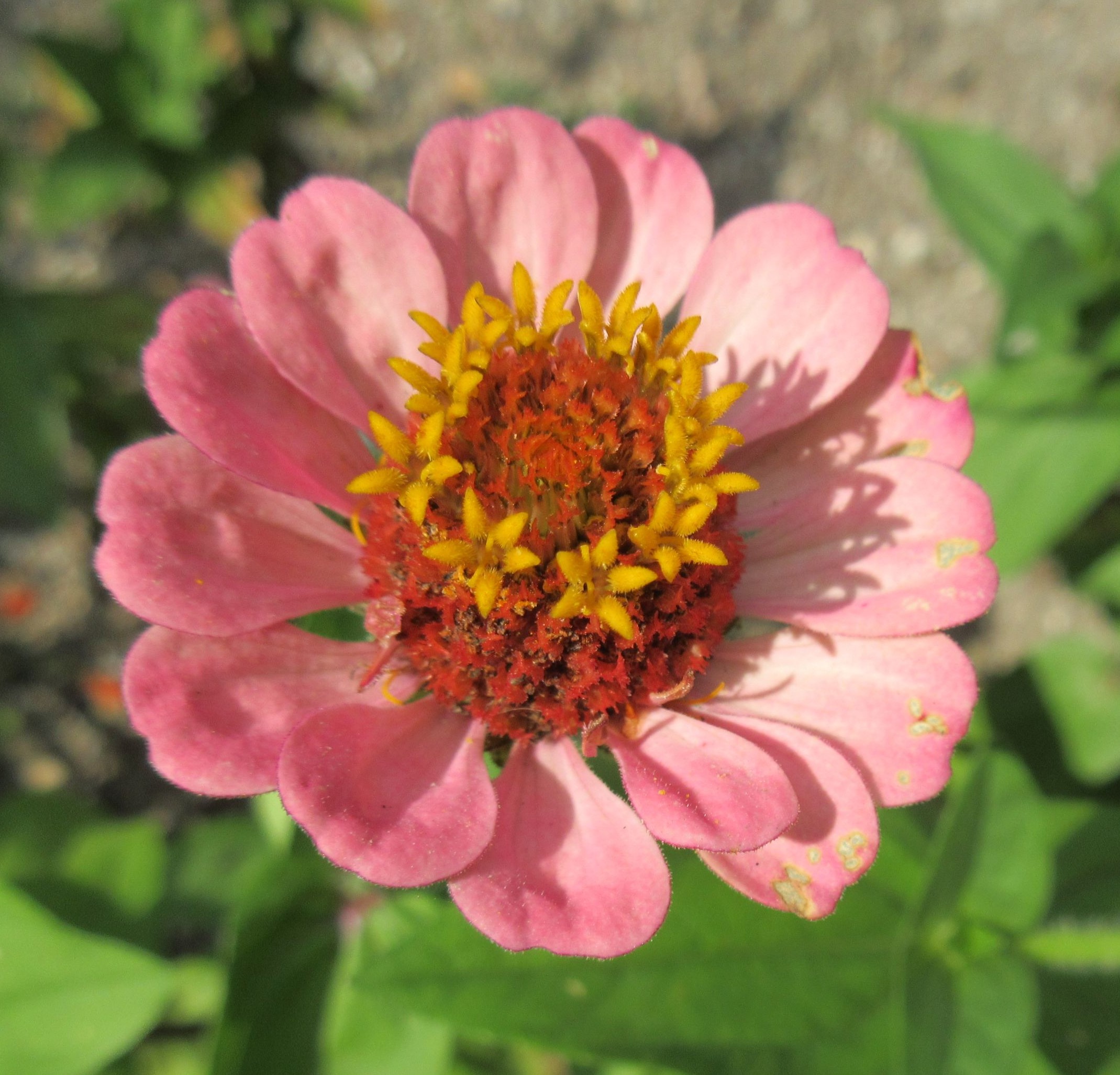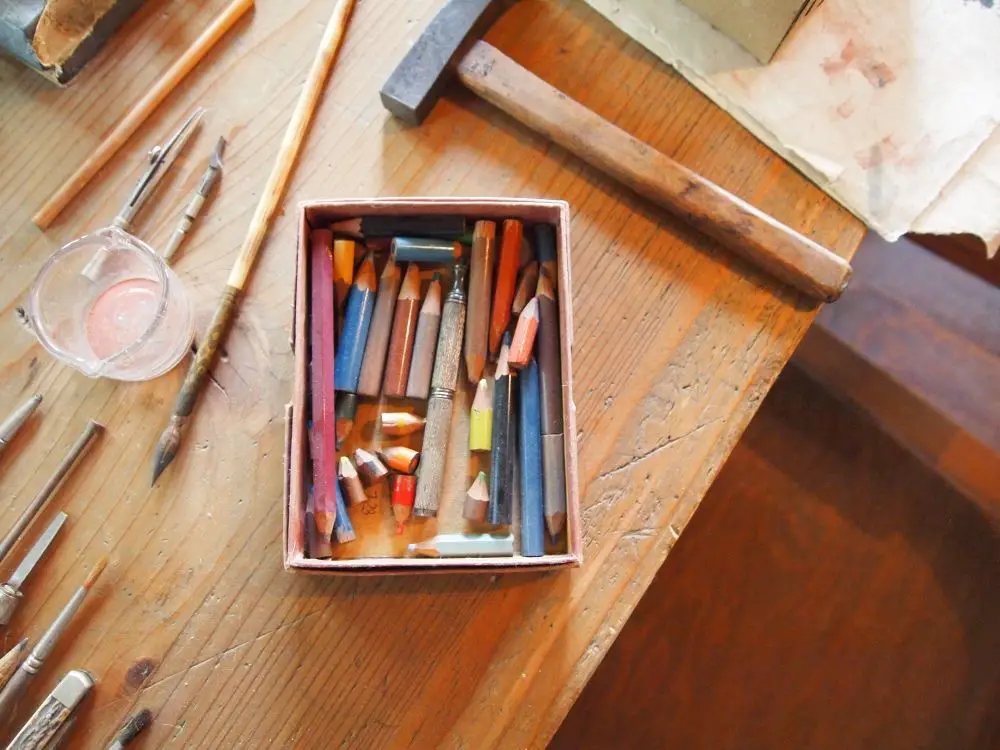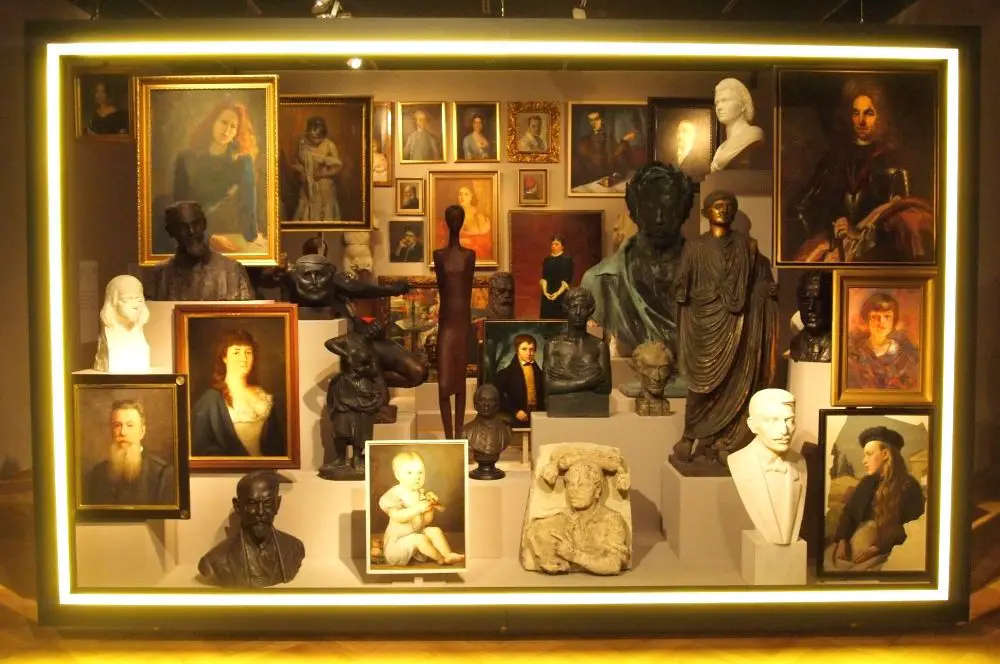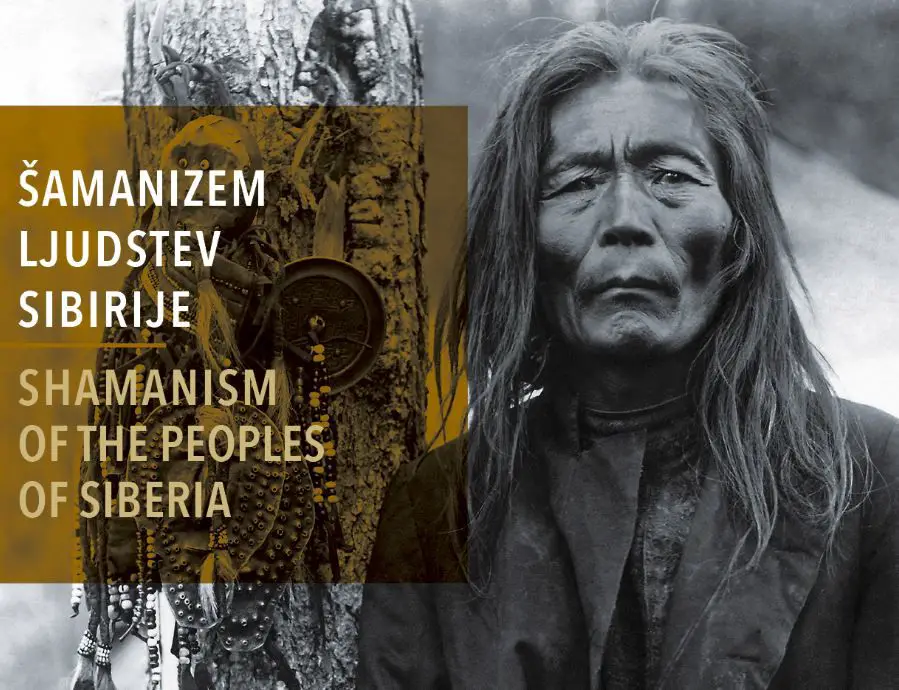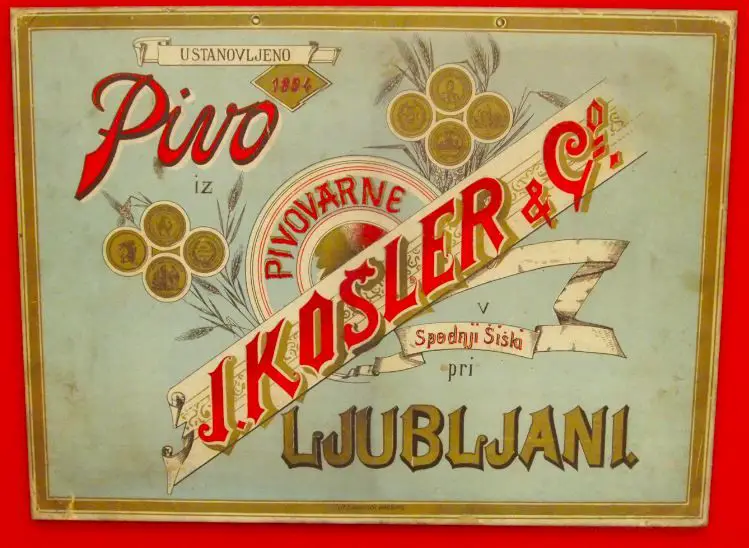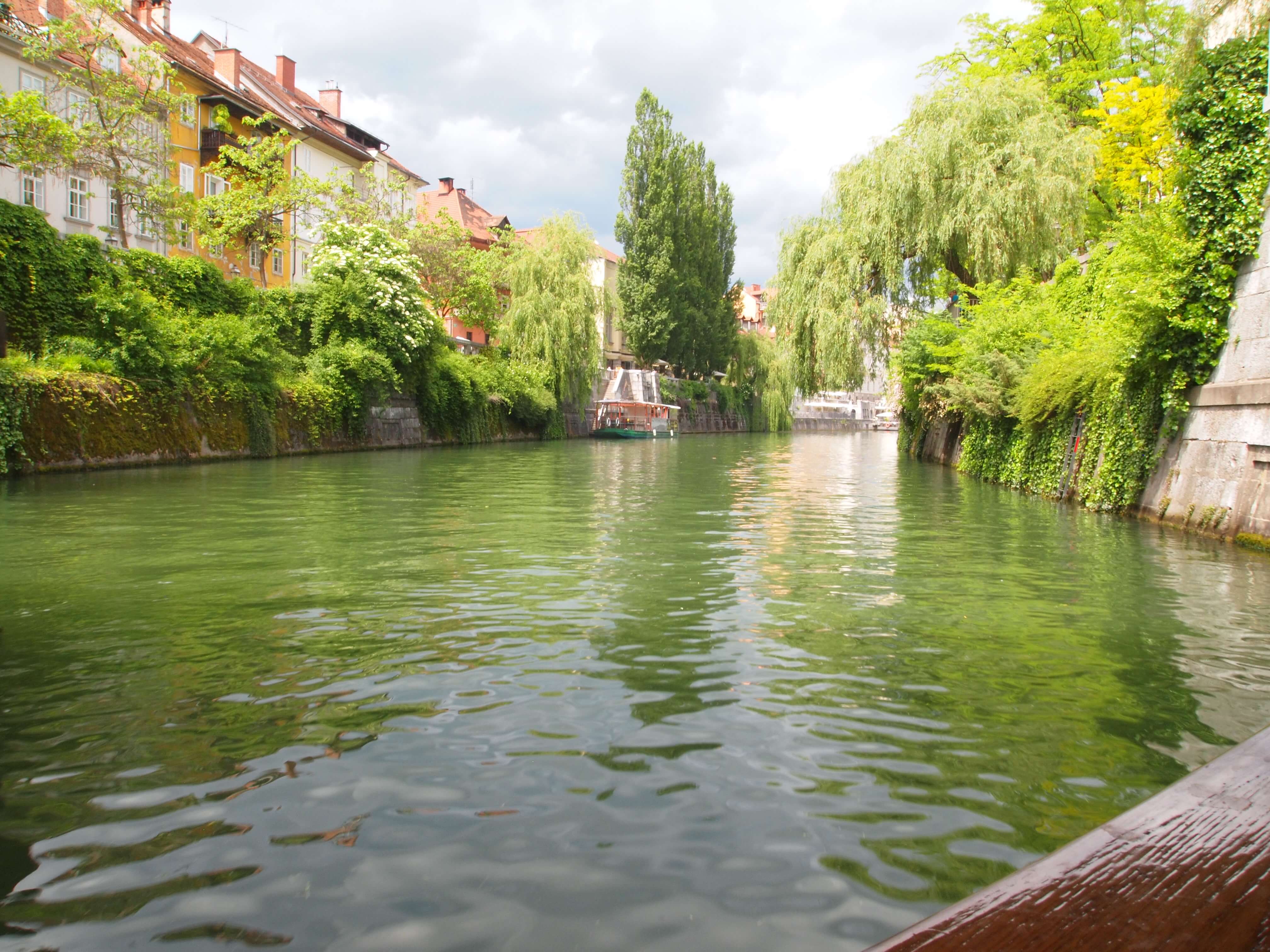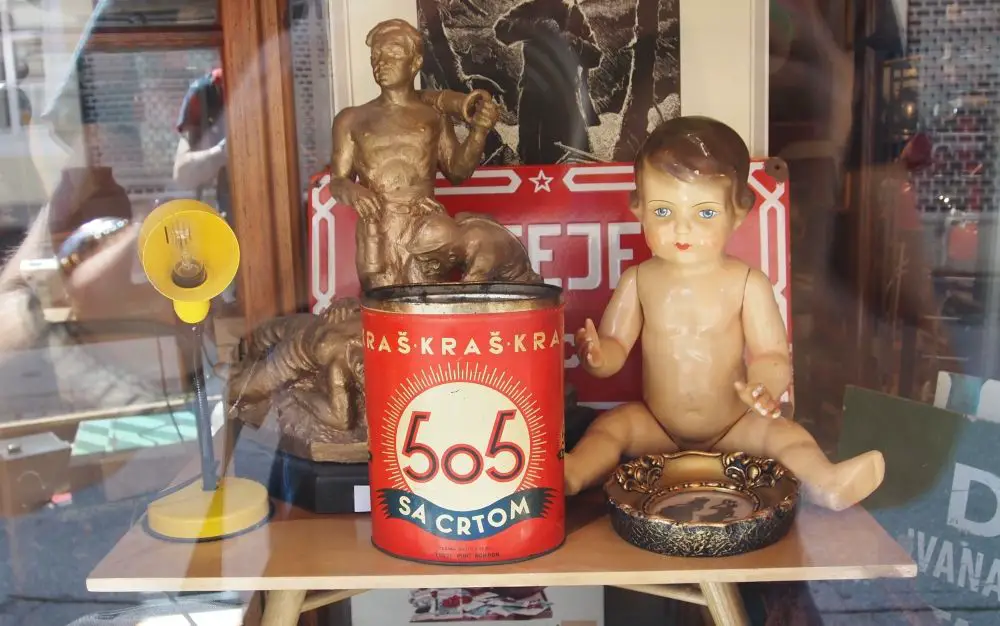News
The Slovenian avant-garde folk trio Širom, made up of Iztok Koren, Ana Kravanja and Samo Kutin, have been getting good reviews for their latest album, A Universe That Roasts Blossoms For A Horse, so we thought we’d put together a post with a few videos to familiarise you with their “imaginary folk music”. You can follow the band on Facebook. They’re about to start a European tour, with their next local show on 3 October (2019) at Ljubljana’s Kino Šiška.
If you're not in town for the week of this guide (19 - 25 August, 2019) then you can see all the editions here, and if there's event or activity you want to promote in a future edition of What's on in Ljubljana please get in touch with me at flanner(at)total-slovenia-news.com or try and find me on Facebook.
In town and want to follow the news? Check out our regular morning headlines for Slovenia here.
As ever, links to the basic listings are after the following selection, while a comprehensive PDF of events for the next seven days, as prepared by Ljubljana Tourism, is here.
Thursday’s a pretty big evening in town, as outlined in the following introduction.
That accordion player in Prešeren? He was playing on Dragon Bridge last week – details
The musical Onegin’s Demon, by Pushkin and Tchaikovsky, will be playing in Križanke as part of the Ljubljana Festival on Monday and Tuesday evening (details). On Thursday and Friday the same venue will see a musical version of The Master and Margarita (details): “St Petersburg’s LDM Novaya Scena theatre has joined forces with 6 composers, 6 librettists and 66 artists to create a blend of fantasy and reality that will captivate audiences with the help of 666 costumes and 66 scene changes.”
Deerhunter are playing Kino Šiška Thursday, 20:00.
Thursday there’s a unique event taking place by Fishmarket Footbridge (Ribja brv), near the Triple Bridge. On the water here there’s be a floating volleyball court with glowing lines to mark the playing areas. There will then be matches between professional players. Free to watch, it starts at 20:15, and is next to the following event.
Thursday to Sunday, 18:00 to 21:00 (also 10:00 to 12:00 on Saturday) at Cobbler’s Bridge (the next bridge down from Fishmarket), there’s 19th Emona Promenade: “a street festival that comprises performances for audiences of all ages featuring theatre troupes and solo artists from different countries. Visitors can observe various fine artists in action and take part in art, music and dance workshops.”
Thursday again you can go to the Cathedral of St Nicholas, the one by the market in the Old Town, for a free concert by Katarina Vega Choir. Until September 15 the Cathedral will also be showing seven sculptural portraits of Pope Francis in bronze by sculptor Mik Simcic.
Starting Saturday (24 August) and running until the end of the month there’s the Young Lions (Mladi levi) international theatre and dance festival – details here.
Here’s all our stories tagged Ljubljana, while all here’s all our stories tagged Piran
TrNOVfest is back for the whole month of August, with theatre and dance workshops, art exhibitions, Indian dances, literary and film evenings, stand-up comedy, graffiti workshops, DJ sessions and more, with food and craft beer to go along with music that ranges from jazz and acoustic to rock, metal, and trap. Tickets at €5, things happen at the Centre of Slavic Cultures France Prešeren, and details are here.
The Ljubljana Festival, which continues until 5 September and has a packed programme of world-class concert, opera, and ballet events – see more here. This Thursday you can hear Schubert, Schumann and Strauss being played by Alena Baeva on the violin and Vadim Kolodenko at the piano at the National Gallery; while on Friday Križanke will host Il Terzo Suono, a baroque ensemble playing Vivaldi, Tartini and Telemann on period instruments.
The Summer in Ljubljana Old Town goes on until 28 August. This presents classical concerts, many of which are free, in the churches, inner courtyards and squares in the old city centre. The programme is here. Running until 1 September is the Mini Theatre’s season for children and young people, with details here.
That said, if you're in town you really should visit Ljubljana Market - it's small, varied and offers fresh fruit, vegetables, local specialities, snacks and souvenirs, while being next to many other sights. Learn more about it here.
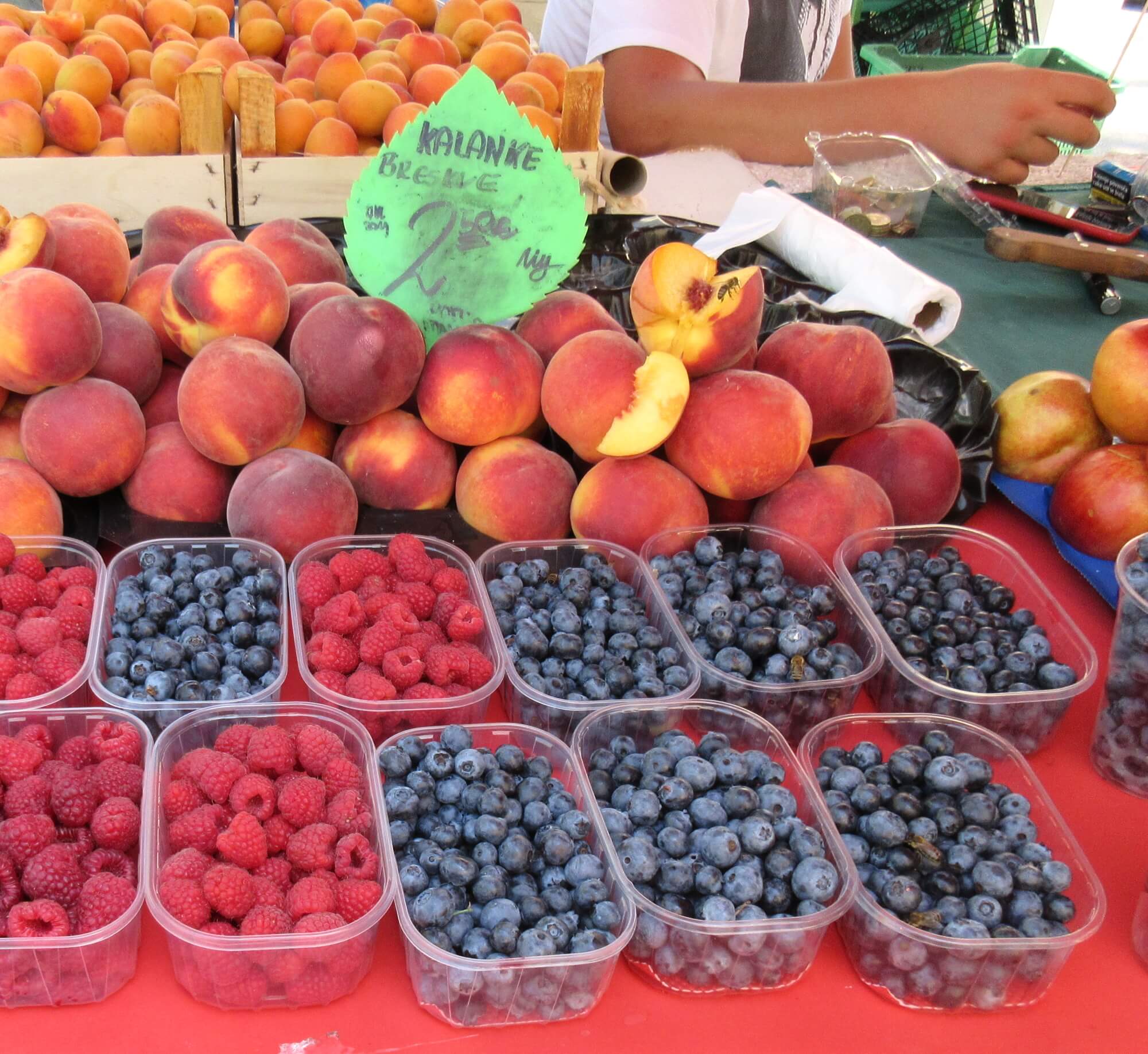
Photo: JL Flanner
Volčji Potok Arboretum (Volčji Potok 3) has a rose garden in bloom until 31 August, nature permitting.
I took a trip to the Botanical Garden a feww week's ago, a short or cycle upriver from the centre. I know nothing about plants but I like them, took a camera and had a good time. All the outside part is free to enter, and there’s a small café with ice cream, coffee and beer.
JL Flanner
If you're learning Slovenian then you can find all our dual texts here
While the Old Town is quaint, and full of music, where does Ljubljana really shop? One popular answer is BTC City, a vast complex of malls, entertainment facilities and more, including more than 70 different food vendors, offering everything from Slovenian to Thai, Indian to Italian, Mexican to Chinese. Check out my recent visit here.
Looking for something different to eat? Trubajeva cesta, running right by Dragon Bridge, has the greatest concentration of "ethnic food" places in Ljubljana, and thus perhaps the country. Check out our walk through guide as of June 2019.
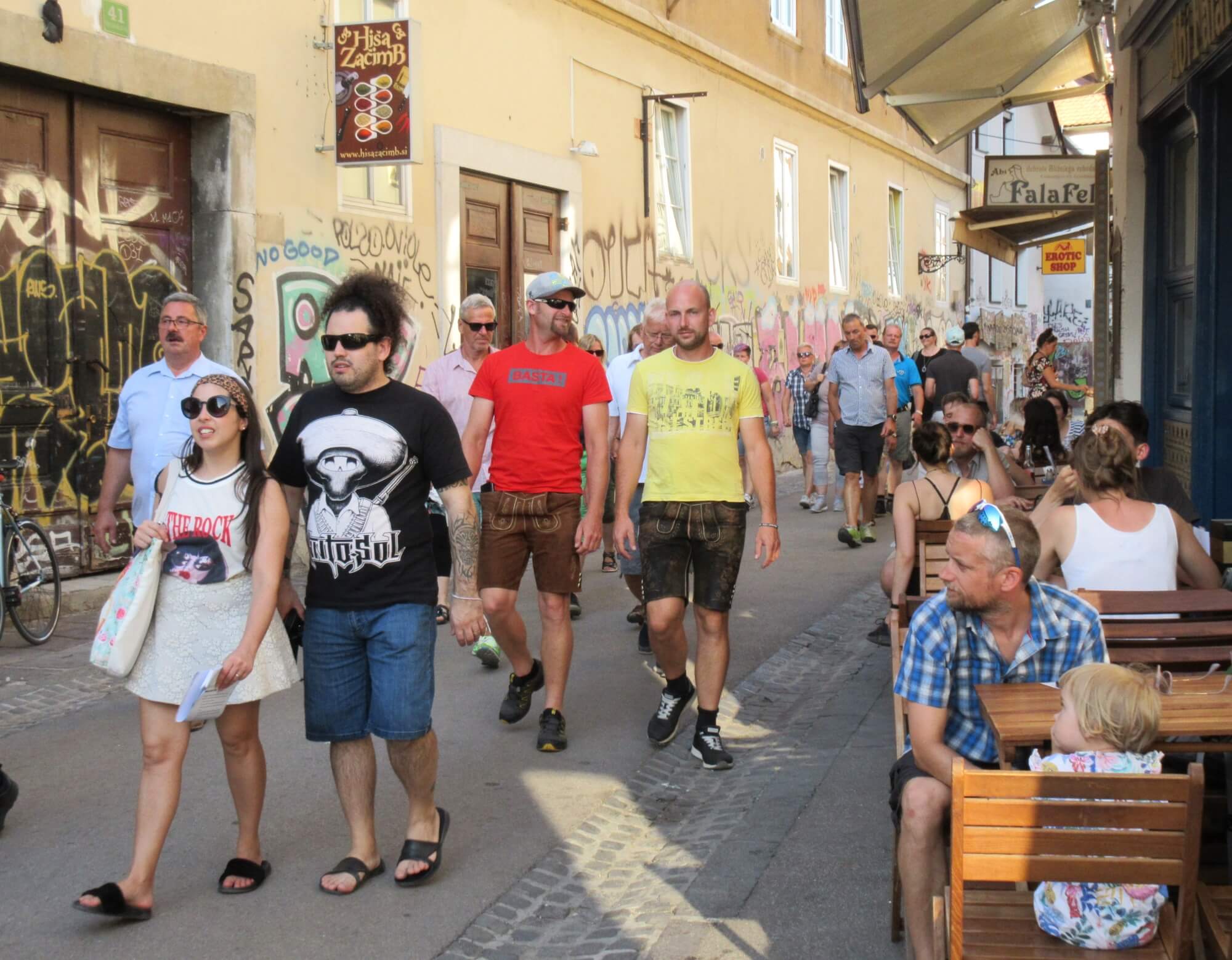
Photo: JL Flanner
Ljubljana is forecast to be the fastest-warming city in the world over the next few decades.
- Cinemas and films
- Clubbing
- Live music
- Theatre and dance
- Harm reduction and drug testing
- Things to do with children
- LGBT+ Ljubljana
- Ljubljana Castle
- Museums and galleries
- Other things to do in Ljubljana
- Daytrips
- Getting around
- Emergencies
Cinemas and films
You can read about all the cinemas in town here, while a selection of what’s playing this week is below, and note that kids' movies tend to be shown in dubbed versions, while non-English language movies for older viewers will have Slovenian subtitles.Parents should also pay attention to Kinobalon, which is Kinodvor's regular weekend series of film screenings and events for children, from babies on up, with special parent/child events, "first time in a cinema" screenings, and babysitting. Learn more about it here, and see the current schedule here.
Note - most children's films will be dubbed (sinhronizirano) - for subtitles look for 'podnapisi'
Film Under the Stars gives you the chance to watch some of the leading art films of the past year outside at Ljubljana Castle, each night at 21:30. The full schedule and trailers are here.
Kinodvor –This is an arts cinema, not far from the train station, that shows new features as well as hosting the occassional festival.
Kinoteka – And not far from Kinodvor you can find this revival cinema, which shows art house classics along with some deep dives in the archives.
Kino Bežigrad - A relatively small theatre, but one which usually has the biggest of the new releases.
Kolosej -The multiplex out at BTC City Mall shows all the big movies, with well over a dozen titles on the schedule, although note that there are far more movies than screens, so some of the older ones mayonly be playing once or twice a week.
Komuna – The cinema in a basement behind Nama department store shows two or three different features a week, usually including the biggest titles.
Looking for a souvenir you'll really enjoy? Take a look at Broken Bones Gin, the first gin made in Ljubljana (learn more here, and try it at the Central Market or selected downtown bars).

Clubbing
Compared to some European capitals it can seem that nightlife in Ljubljana ends rather early, especially along the river, but there are still bars that stay open late and clubs were you can dance until dawn, and perhaps the best place to stumble across something interesting is the legendary Metelkova. Be aware it's a grungy kind of place and not for all tastes, but also that there's considerable variety to found within the various clubs there, from death metal to electropop, gay cabaret to art noise. You can read "the rules" of the place here. And if you're curious about how the place started then read our story, and look at some pictures, about last year's 25th anniversary.
Božidar - DJ events aren't too common here, but when they happen they often have a big name.
Channel Zero – DJs shows here include regular dub nights as well as electronic music.
Gala Hala – Another Metelkova venue, you can sometimes hear bhangra and Bollywood here, but more often funk, hip hop, breakbeat and so on.
Klub Cirkus – The more commercial end of clubland, and a venue that aims to serve the student party scene. Expect house, anthems, and bangers.
Klub K4 – The home of techno, old and new, along with various other electronic genres,
Koncertna Dvorana Rog– There are irregular DJ sets at this underground (not literally) venue at the far end of Trubarjeva cesta, and they range from techno to goa to drum'n'bass.
Orto Bar– 80s and 90s throwback nights can often be found here, along with rock-based DJ sets.
Live music
Balassi Institute – Free Hungarian music, when available, from the Hungarian cultural institute just a short walk downriver from Dragon Bridge.
Cankerjev dom – The main arts venue in the country hosts classical, opera jazz, folk and occassinally pop.
Cvetličarna – Regional pop and rock concerts can be found here.
Channel Zero – This Metelkova venue sees live shows from punk and rock bands, as well as others.
Gala Hala – Another Metelkova venue with indie bands of various styles.
Kino Šiška – One of the top live venues in the city, with a varied programme that include indie, rock, pop, experimental, hip hop, and so on.
Klub Gromka – Live music is often metal, from sludge to stoner, death to thrash, while punk bands also appear, as do others.
Križanke – The venue that hosts the Ljubljana Festival often has classical music, and some rock, in the open air.
Ljubljana Castle – Jazz, funk and pop every Friday night.
Orto Bar– The home of live rock, metal, punk and other guitar-based genres.
Pinelina dnevna soba – LIve music is rare here, but it does happen.
Slovenska filharmonija– Classical music in the centre of town.
SNG Opera and Ballet - As the name suggests, here you'll find the best of opera and ballet in the country.
Španski borci - While dance is more common here, they also have some contemporary and experimental music shows.
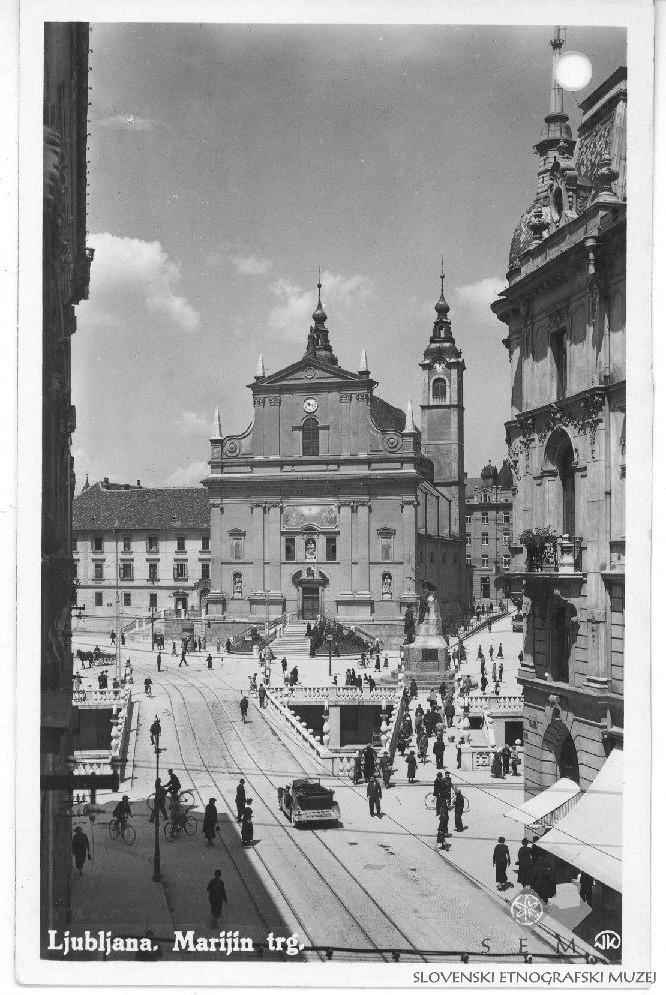
See more pictures of Old Ljubljana here
Theatre and dance
Cankerjev dom- The main arts venue in the country always has something of interest going on.
Gledališče IGLU - IGLU Theatre – Saturday night this group is usually putting on an English improv show somewhere in town, but it’s generally promoted after this is written, so check the Facebook before putting on your shoes.
Kino Šiška – One of the top live venues in the city also hosts some dance performance, often of the more experimental variety.
Mini Teater Ljubljana –The English schedule of varied performances, for adults and children, for the month is here.
Ljubljana Puppet Theatre - Puppetry has a long and noble tradition in Slovenia, and you can see performances for children and adults (including non-puppet shows) drawing from the Theatre's rich repetoire as well as new productons.
SNG Opera and Ballet - As the name suggests, here you'll find the best of opera and ballet in the country.
Španski borci - The home ofcontemporary dance(and the EnKnapGroup) in Slovenia.
Pocket Teater Studio– There are regular flamenco evenings at perhaps the smallest venue town, but note that the number of seats is very limited, and thus you should make a reservation via This email address is being protected from spambots. You need JavaScript enabled to view it. or 070 325 522.
Harm reduction and drug testing
Drogart is an organization that aims to minimise harm on the party scene, and offers drug-testing services and reports on their webpage. It’s in Slovene, but you can Google translate it or work things out yourself, and our story on the group is here.You can find the latest warnings on fake drugs and high strength pills and powders (in Slovene) here. However, be aware that all the usual drugs are illegal in Slovenia.CBD is legal, though, and our retailer of choice can be found on Trubarjeva cesta - read more about Sena Flora here.
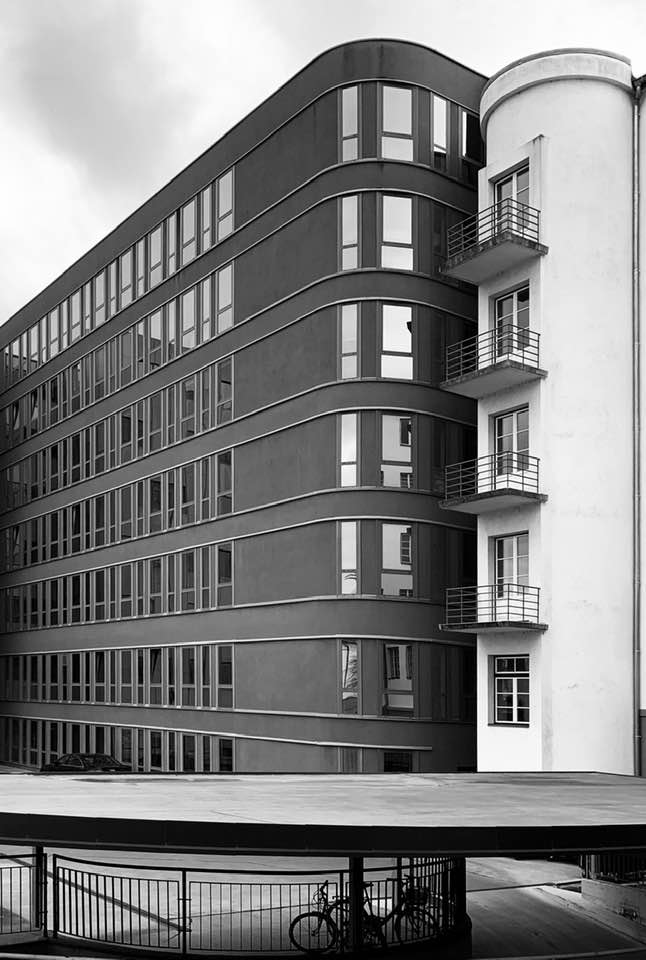
Photo: Igor Andjelič. See more of his work here
Things to do with children
You can find our Top 12 list of things to do with kids in Ljubljana here. If want to read more about the philosophy behind the wonderful House of Experiments look here, while our trip to the Museum of Illusions is documented here, and there’s always riverside walks, pizza and ice cream. With regard to the latter, take a look at our guide to six places that serve good ice cream in winter, and thus are serious about the dessert.
Mini Teater Ljubljana – The season sees a lot of puppet performances for children, in Slovene, at this theatre not far from Križanke. The English schedule for the month is here.
Ljubljana Puppet Theatre - The puppet theatre near the Central Market and next to the Castle funicular has a full programme or shows, for children and adults, with the schedule here.
Vice meets Žižek in Ljubljana. If you want to see more of the most successful writer who lives in Ljubljana, click here
LGBT+ Ljubljana
If you're looking for more general links on "gay Slovenia", including a history of the scene and various projects, then you can find that here, while our stories about the community can be found here.
Klub Monokel – This lesbian bar in Metelkova is open every Friday, although sometimes there are other events
Klub Tiffany –And the gay bar next door is also open on Fridays. Other things coulds also be planned, so click on the name to find out.
Pritličje – This seems to be the only "always open" LGBT-friendly cafe / bar / events space in town, and perhaps the country, so it's a good thing it's such a good one, open from morning to night, and with fliers and posters letting you know what's happening outside the narrow confines of, say, a general interest online what's on... guide.
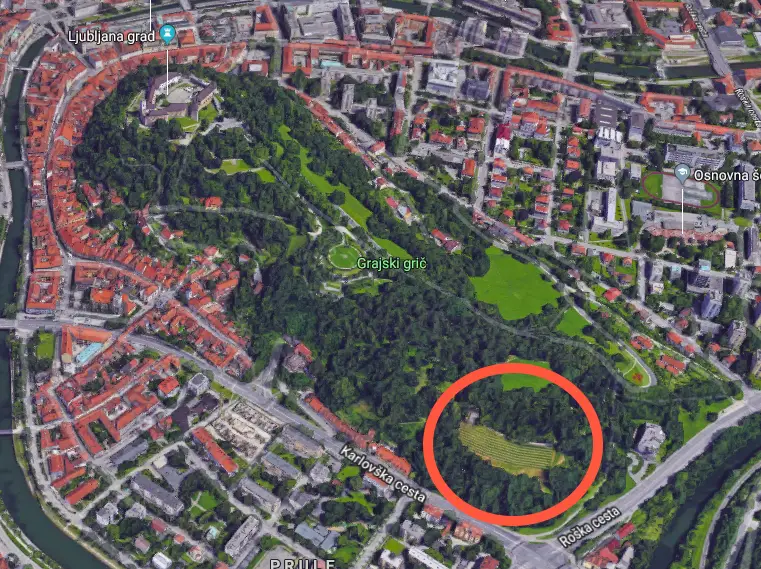
Screenshot from Google Maps, showing the location of the Castle vineyard
Ljubljana Castle
The city’s main attraction is said to be the top tourist draw in the country overall, and to my mind it earns a spot near the top just for the history and views. But beyond that the current owners, the City of Ljubljana, have laid out a varied, interesting and enjoyable programme of events, one that rewards regular revisits. On until 17 November Mighty Guardians of the Past: Castles in the Slovenian Lands, a presentation that delivers on the promise of its title.
I try and get up there every Saturday morning to clear my head and move my feet on the trails, and never tire of that end of the hill. At the other end, where the Castle sits, there’s a lot more than fresh air on offer. There are guided tours, restaurants, a café, Castle museum, puppet museum, a Watchtower you can climb to the highest point in the city, art shows, dances, live music, movies under the stars, festival days and more – enough to reward multiple trips up the hill through the year. All of these activities and events can be found on the Castle website, while on TSN you can see “25 things to know about Ljubljana Castle” here, and “Ten Ways to Enjoy Ljubljana Castle” here.
Museums and galleries
Most public galleries and museums are closed on Mondays, although not the National Museum.
Looking to buy some high end, big name local art from a trusted gallery? Check out our look at Sloart.
Cankerjev dom – On until 3 March 2020 there's an exhibition on Ancient Greek Science and Technology. Details here.
Plečnik's desk. Photo: JL Flanner
Plečnik’s House is worth a visit if you want to learn more about the architect who gave Ljubljana much of its character, and it's also in a really nice part of town, Trnovo, just a short walk or cycle upriver. Read about our guided tour here.
Balassi Institute – The Hungarian culture centre is next to a Spar and Hofer, and not far from Dragon Bridge, and always has something interesting going on. Learn more here.
City Museum – The Museum in French Revolution Square an interesting permanent exhibition on the history of Ljubljana, from prehistoric times to the present day, with many artefacts, models and so on that bring the story alive.You can read about my visit here. On until 25 September is Treasures from Russian Museums, an exhibition showcasing more than 80 Russian icons from leading Russian museums. Also on until 15 September can see the results of the archaeological research of Gosposvetska cesta, Slovenska cesta, Prešernova cesta, Erjavčeva cesta, Tribuna, Križanke, Dalmatinova ulica, Vegova ulica (KGBL) and the area of the University of Ljubljana. Especially interesting for those who know the city.
The Faces of Ljubljana in the City Museum. Photo: JL Flanner
International Centre of Graphic Art – The 33rd Biennial of Graphic Arts runs until 29 September. It's called Crack Up – Crack Down, and is curated by the collective Slavs and Tartars, with a focus satire and the graphic arts. Learn more here.
Jakopič Gallery – Until 29 September you can see the photographs of Lucien Hervé in a show called Geometry of Light
Kapelica Gallery, Kersnikova 4 – In the same building as Klub K4 you can enjoy Earth Without Humans: 'On The Boundaries Of Artificial Life' until August 23, described as follows: “We have started trusting high-tech more than we trust our close friends and family and an increasing number of technology manufacturers are becoming aware of this. The applications that they are developing are becoming increasingly smart and cooperative, while also becoming increasingly aesthetically neutral and humanised.”
Ljubljana Castle on until 17 November Mighty Guardians of the Past: Castles in the Slovenian Lands, a presentation that delivers on the promise of its title. There's also the Parallel Worlds of Alan Hranitelj runs on until September 8, showing the work of the acclaimed costume designer. Until 15 September you can see Jelka Reichman’s illustrations from the picture book Twelve Elephants, written by Leopold Suhodolčan (free admission).
MAO – The Museum of Architecture and Design has much of what you'd expect, along with some temporary shows and a good cafe. On until 19 September is a show called Creators, on contemporary Slovenian fashion and textile design, which is being promoted with the following image.
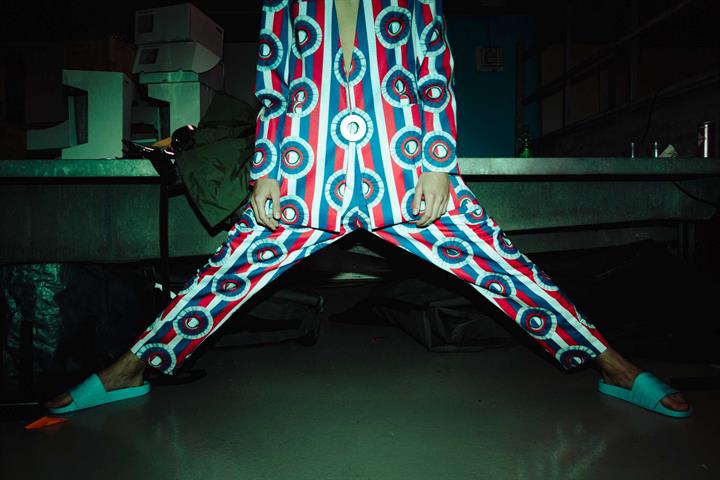
Photo: Urša Premik
Moderna galerija – The main branch of this gallery, to be found near the entrance to Tivoli Park, has a good collection of modern art, as well a nice café in the basement. Opening Thursday, April 25th, 20:00, The Visual Arts in the Kingdom of Yugoslavia, 1929–1941, which then runs until September 15th 2019. This offers “an overview of painting, sculpture, printmaking, drawing, photography, and film from the time the king's dictatorship was set up (6 January 1929) to the beginning of World War II on Yugoslav soil (April 1941)” - you can read more about it here. The museum's Metelkova branch also has a big new show, runing until at least September 2019, an the art of the Non-Aligned Movement, with an example shown below. Until September 15 you can also enjoy Maja Hodošček, a video artist you “explores social relations through the politics of exchange and collaboration; in particular, she is interested in speculative models of representation in relation to the documentary.”
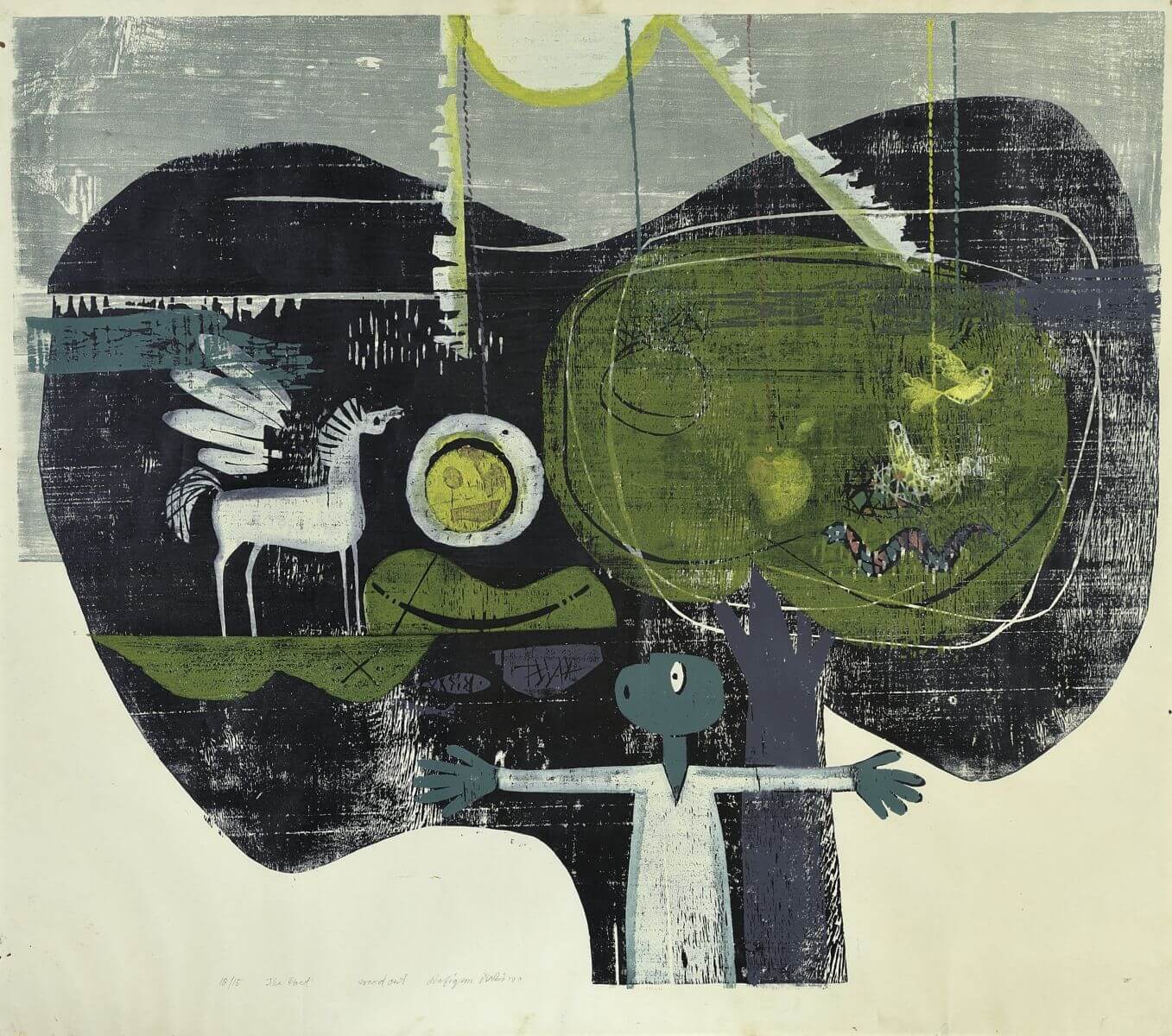
Rafikun Nabi: Poet, 1980, print, 96.5 x 110 cm. Courtesy of the Contemporary Art Center of Montenegro. On display at the Metelova branch of the Moderna galerija
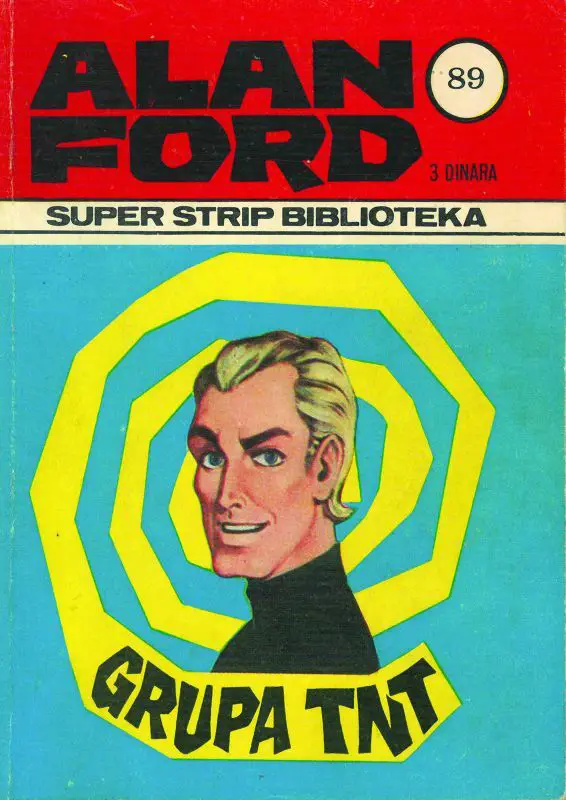
Alan Ford at the National Gallery
National Gallery – The country’s main gallery has “the best” of what’s on offer from the Middle Ages to non-contemporary modern visual arts, and is in a great location for exploring other areas, just by Tivoli Park and opposite the main branch of the Moderna galerija. You can read about our visit to the room containing sacred art from the Middle Ages here. The Space Within the Space: Scenography in Slovenia before 1991 will provide a comprehensive historic, stylistic, visual and theatrical overview of Slovenian scenography until 8 September. There’s also a big show on Alan Ford, one of the great comic books of the Yugoslav era, on until 13 October.
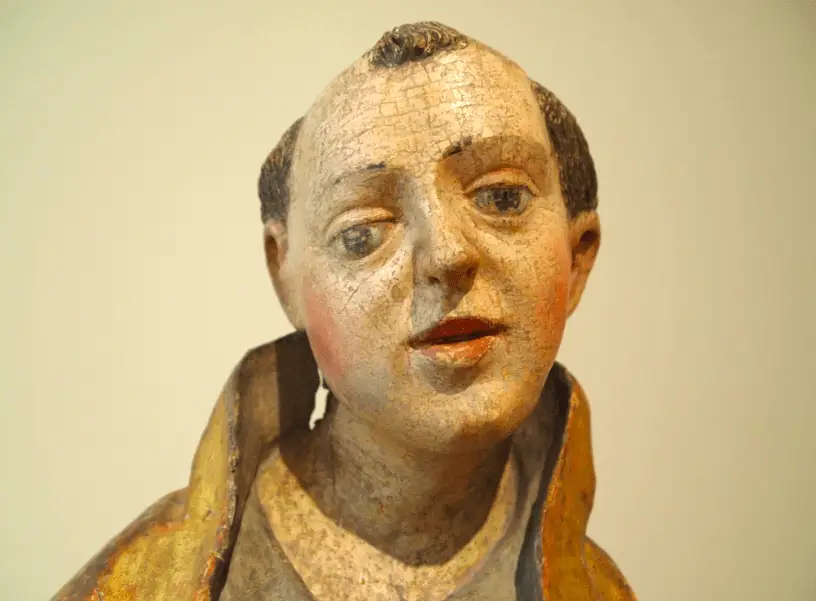
JL Flanner
The real Robba Fountain can be found in the entrance to the National Gallery - the one you see in the Old Town is a genuine fake, as seen below and reported here.
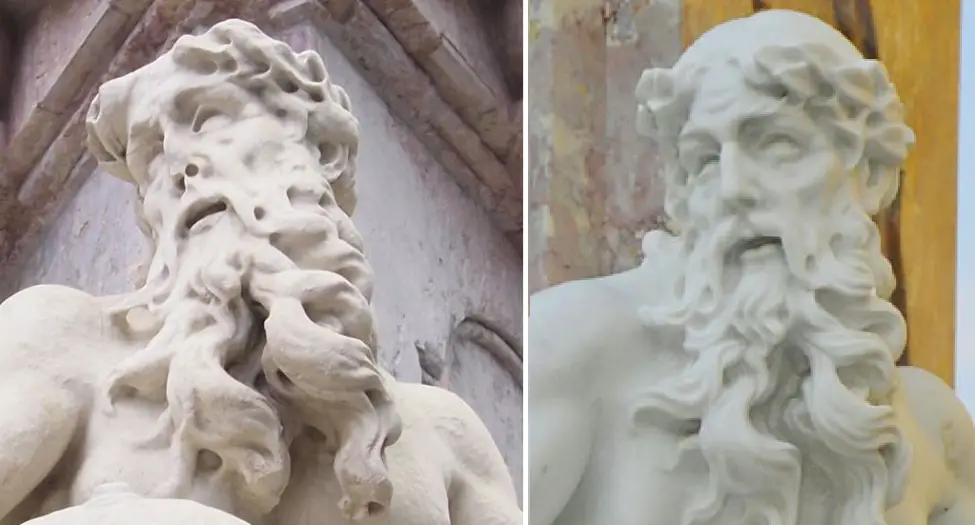
Photo: JL Flanner
National Museum of Slovenia – There’s plenty to see in the permanent collection here, from Roman times, Egypt and more. Running until 3 November is Roma Aeterna: Masterpieces of Classical Sculpture. With sculptures from the collection of the Santarelli family in Rome, ranging from the age of the Roman Empire to that of neoclassicism. Meanwhile, the museum's Metelkova branch, located between one branch of the Moderna galerija and the Ethnographic Museum has some rooms on Church art, furniture and weapons, with the latter including more guns than you'll see anywhere else in town, and quite a thrill if coming from a nation where such objects are not household items.
Natural History Museum – On until the end of December 2019 is Our Little Big Sea, which takes a look at the oceans.
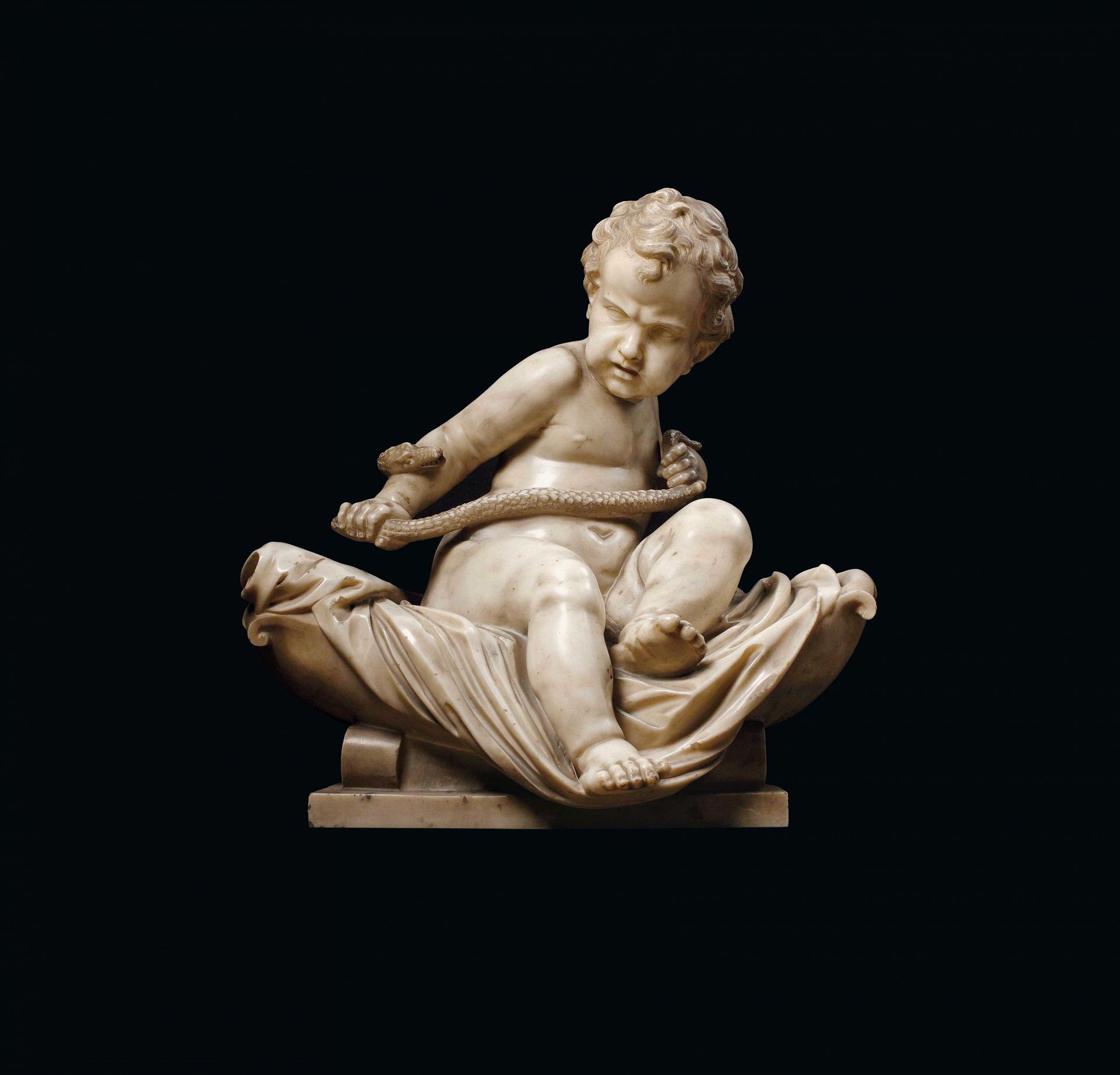
Roma Aeterna: Masterpieces of Classical Sculpture - see below
National Museum of Contemporary History - Tucked away in park Tivoli, in addition to its permanent collection and until 29 September there also a retrospective on the photographer Edi Šelhaus, which is being promoted with the following image.
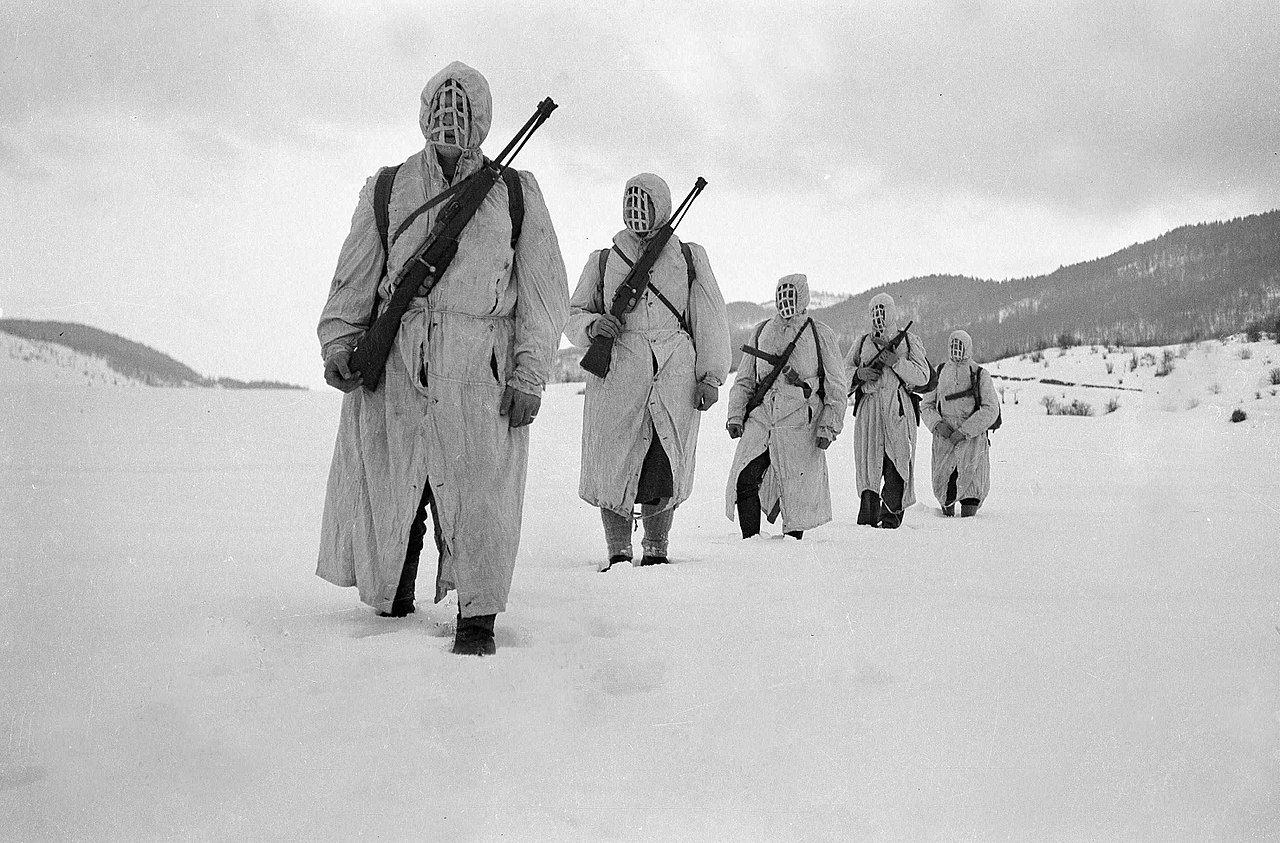
Photo: Edi Šelhaus
Slovene Ethnographic Museum – The museum has two permanent exhibitions. One of these is called Between Nature and Culture, and has a great collection of objects from Slovenia and around the world, well worth the trip up to the third floor to see it (as recounted here). From April 18 until October 19 (2019) you can also see a show calledShamanism of the Peoples of Siberia, from the Russian Museum of Ethnography, Saint Petersburg. The place is located near the newer branch of the Moderna galerija and Metelkova. You can read about this fascinating show here. On until September 15 is Petra Šink: The circle between design and nature, in which the award-winning designer takes visitors through the life cycle of useful products for the home which are made from natural biodegradable fungal materials.
Town Hall – On until 22 August there’s a show from Miha Štrukelj with paintings of cities in Taiwan and China, called Alter Ego of Cities.

Miha Štrukelj, Shopping District, 2016, acrylic, ink, charcoal, pencil, crêpe paper on canvas, 300 x 225 cm
Union is "the Ljubljana beer", but now both it and Laško are owned by Heineken. There are many local brews on offer around town, though, if you want to explore IPAs, stouts, wheatbeers, sours and so on Photo: JL Flanner
Union Experience – The Ljubljana-based brewer has a museum showing the history of the company, with the ticket also including access to part of the factory and a few samples of the product. You can read about our visit here.
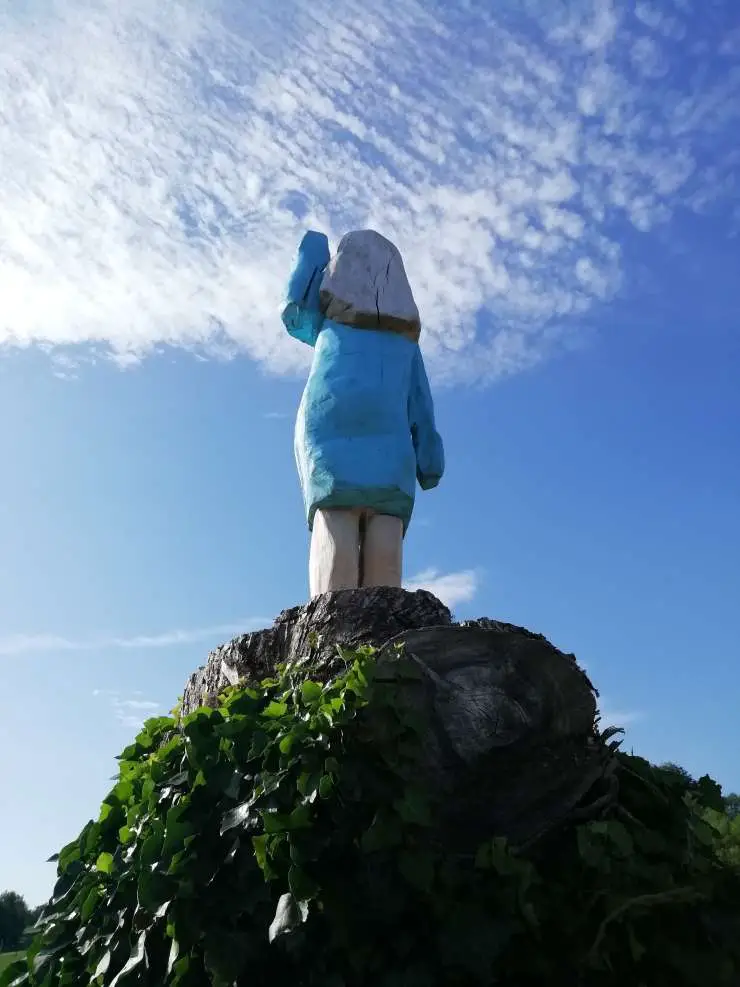
Vžigalica Gallery – If you’re curious about the man who commissioned that Melania Trump sculpture, then you can see more of activities here, in a show called Brad Downey: This Echo.
Volčji Potok Arboretum - Running until 3 November you can see a large collection of cacti here.
It's not a formal museum, but if you're interested in "Yugo-stalgia" then you'll enjoy a trip to Verba, a small, privately run space that's crammed with objects and pop culture items from the era, and is conveniently located at the start of one of the short walks to the castle. It's also a great place to take pictures, if you leave a donation, and you can read more about it here.
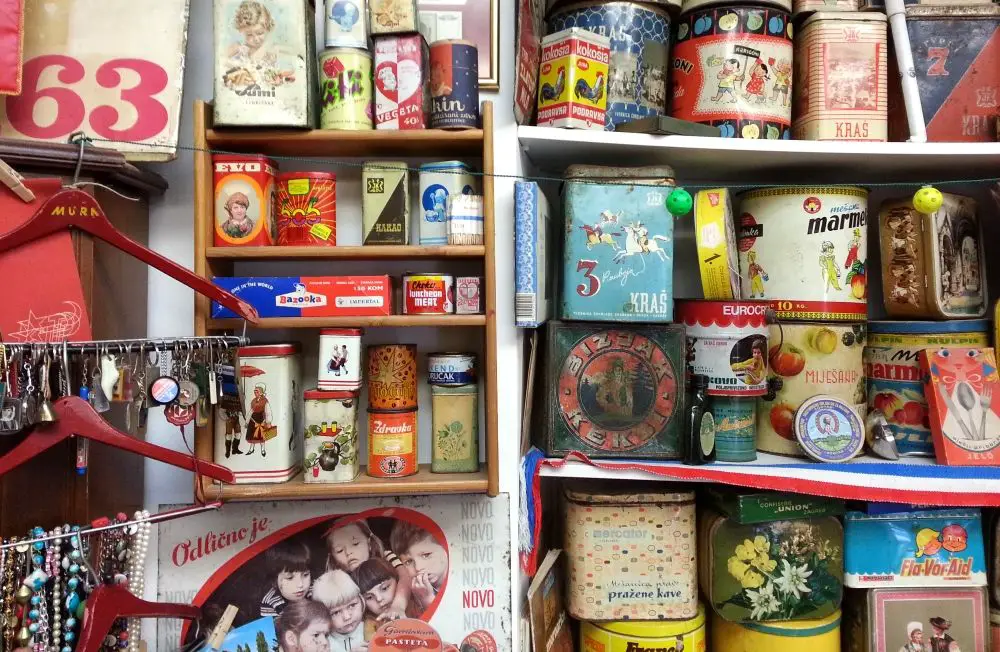
Verba. Photo: JL Flanner
Alternative Ljubljana isn't a museum or gallery, as such, but instead turns the city streets into a museum and gallery. Learn more about their tours of street art, history and LGBT Ljubljana here.
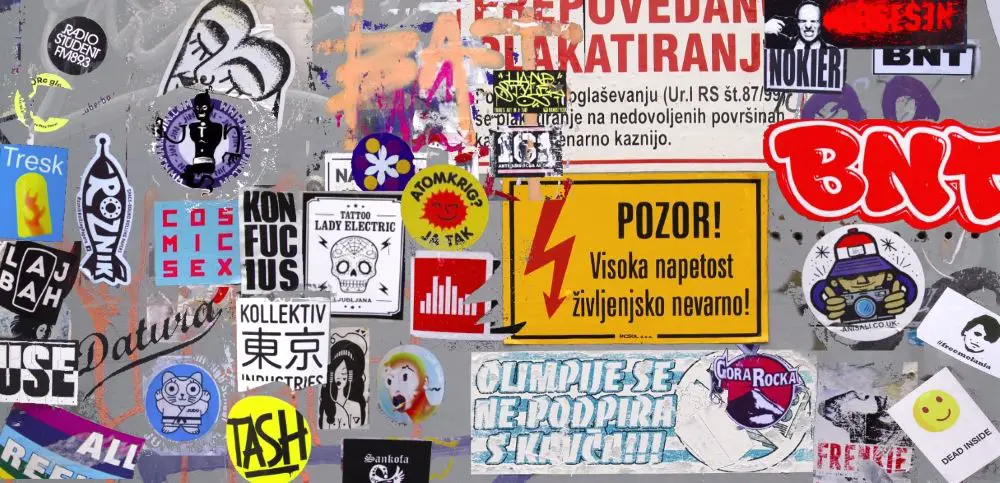
Photo: JL Flanner
Other things to do in Ljubljana
Learn more about Ljubljana with "25 things to know about Slovenia's green city of dragons", or take a look at our guide to spending from four to 48 hours here.
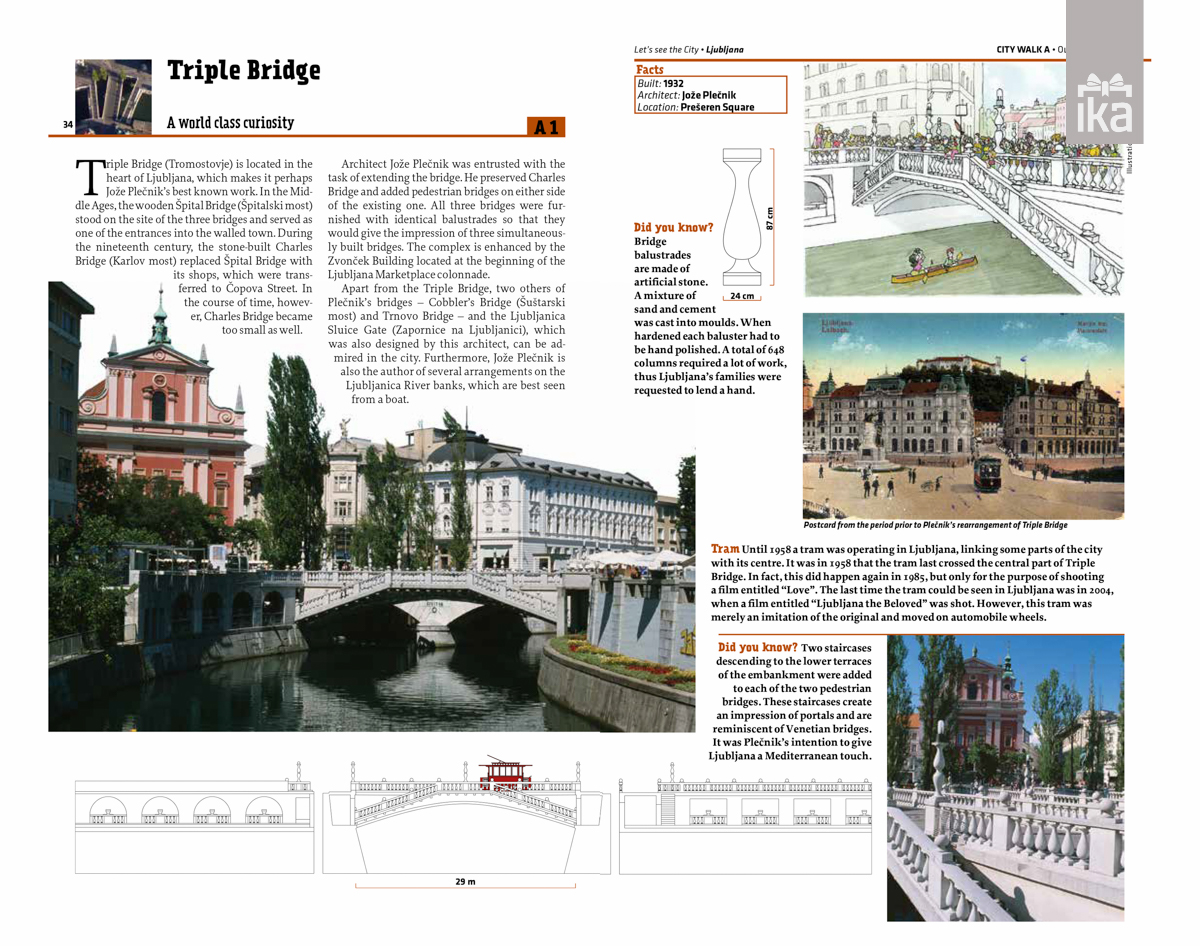
If you like the city's architecture then check out this great book, Let’s See the City - Ljubljana: Architectural Walks & Tours, with our review here and a page from the book shown above. We took a walk with one of the authors who showed us how much there is to learn and enjoy if you slow down and pay attention - read about that here.
Open Kitchen brings market stalls selling food and drink from some of the best restaurants in town every Friday, from 11am to 11pm, in the square between the cathedral and the river - just follow your nose and the crowds. Read more about it here.
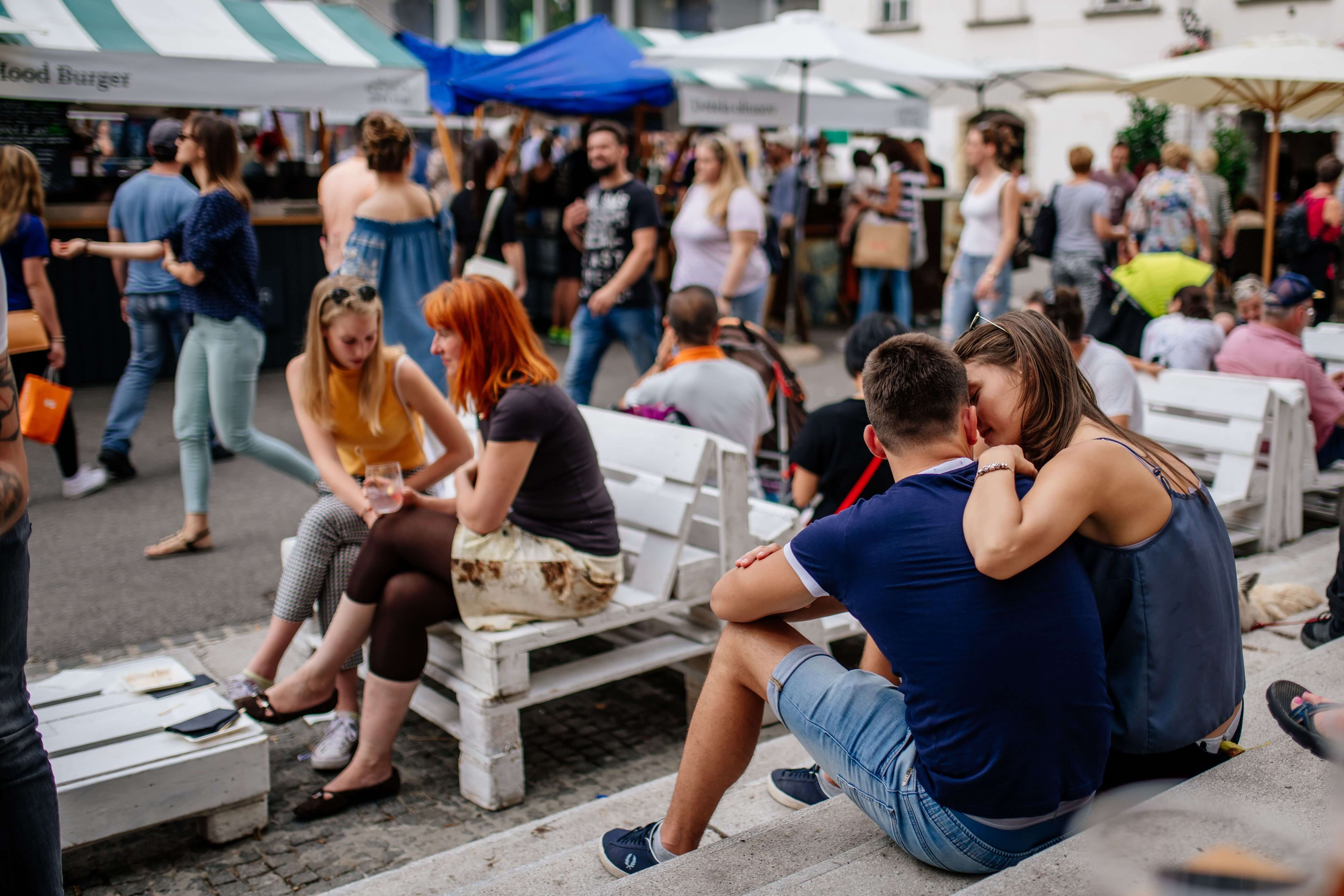
Photo: Open Kitchen
Ljubljana has some beautiful buildings from the early 20th century, in the Secessionist style, like the one below. Learn where to find them here.
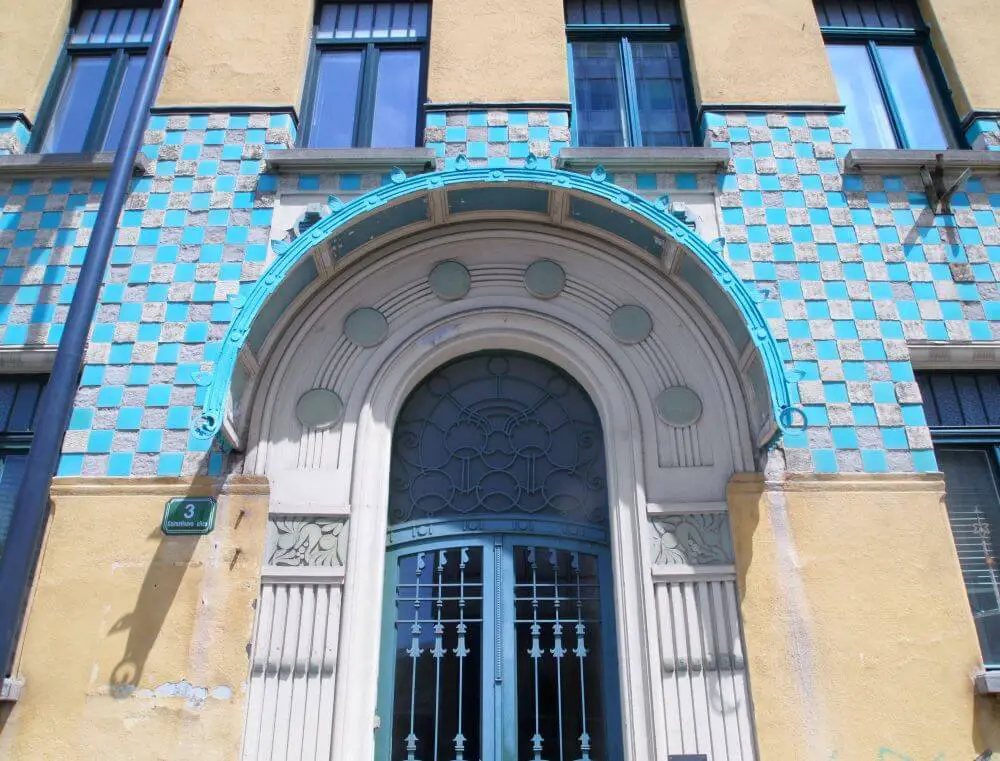
Photo: Neža Loštrek
For something a little more brual, check out Republika trg / Republic Square, in the heart of the political quarter.
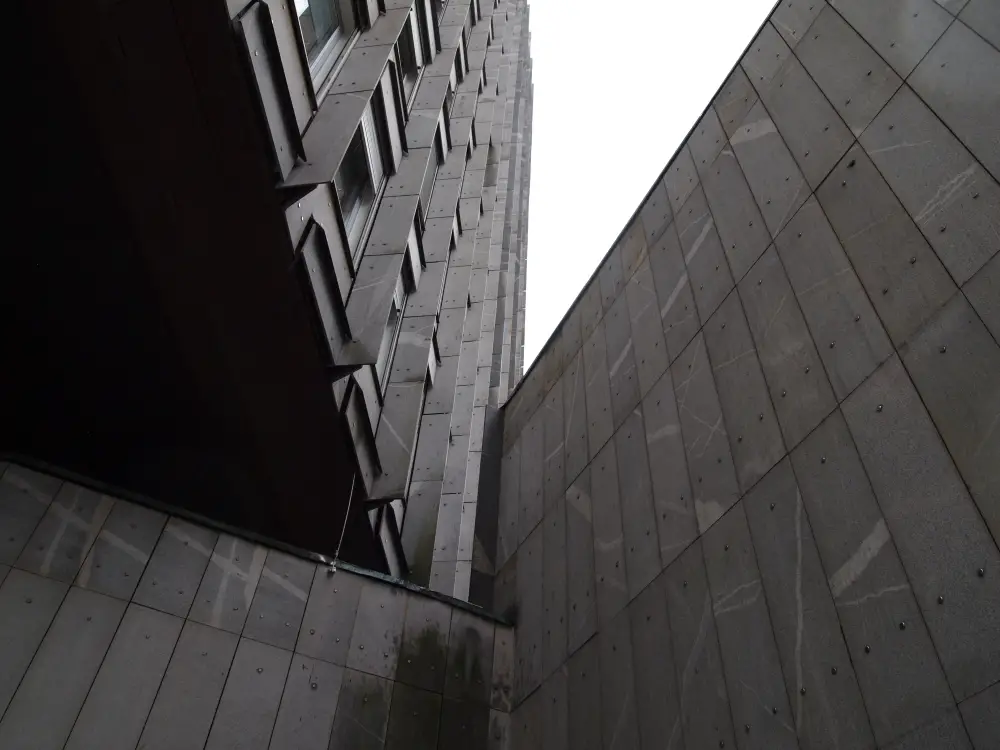
Photo: JL Flanner
Photo: JL Flanner
Some view of the city you can only get from the river. If you'd like to take a boat ride then read about my experience here. If you prefer to get in the water rather than on it, then here's a guide to the various open air pools in Ljubljana. Note that it was written last year and so the prices and times may have changed, so do click the links and check.
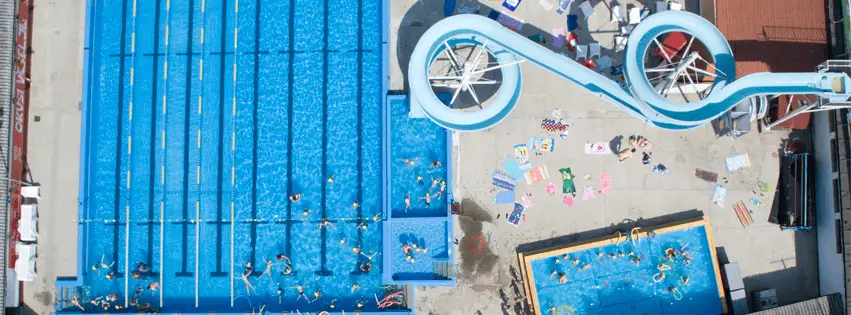
If you'd like to spend an evening painting with others, then take a look at Design with Wine, which organises painting parties on Trubarjeva cesta,
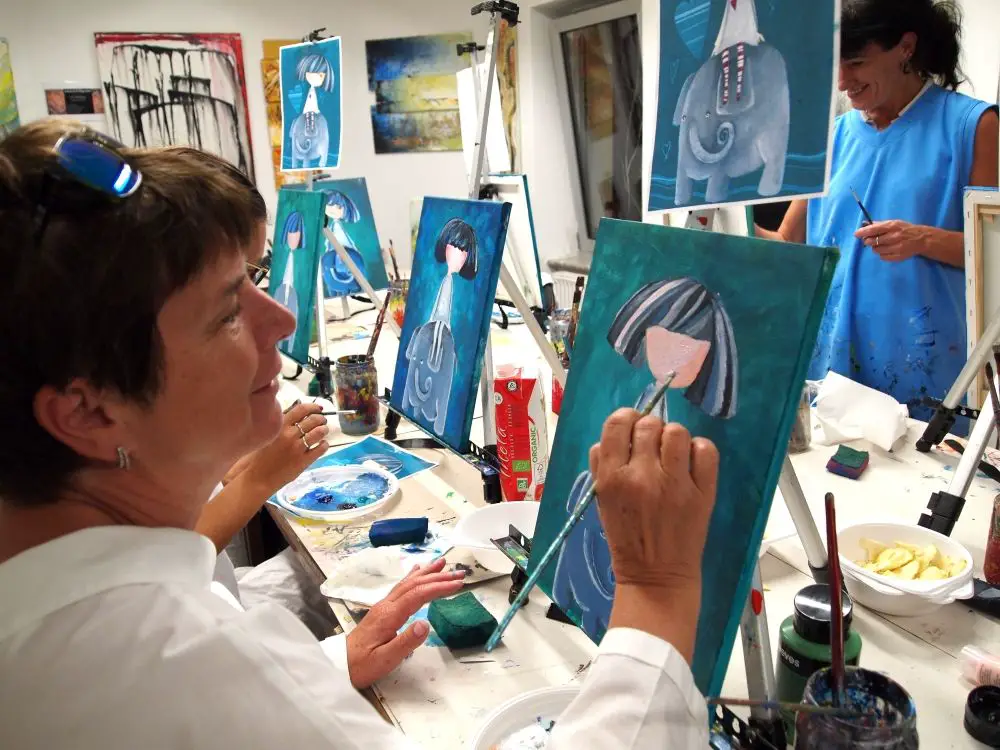
If you want to see some antiques, then check out the wonderful Antika Carniola, as discussed here. The man behind it, Jaka Prijatelj, has a fine eye for life on this street, as you can see on his Facebook account.
Photo: JL Flanner
If you’re in town and want to go jogging or walking in nature, why not take another look at the Castle, with a brief guide to the trails here. If you want something bigger, head to Tivoli Park.
And if you're bored with the Old Town, why not take a walk, cycle or boat ride to nearby Špica and enjoy the riverside life. Learn more about that here.
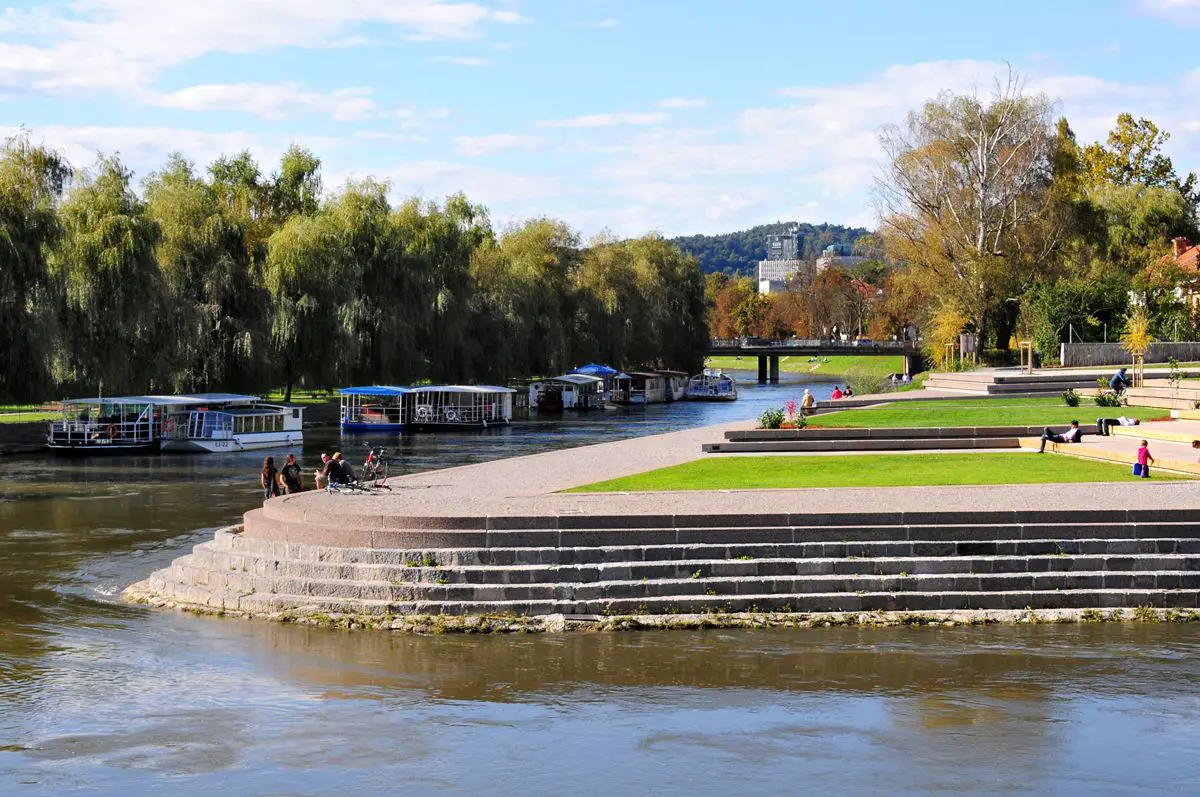
visitljubjana.si
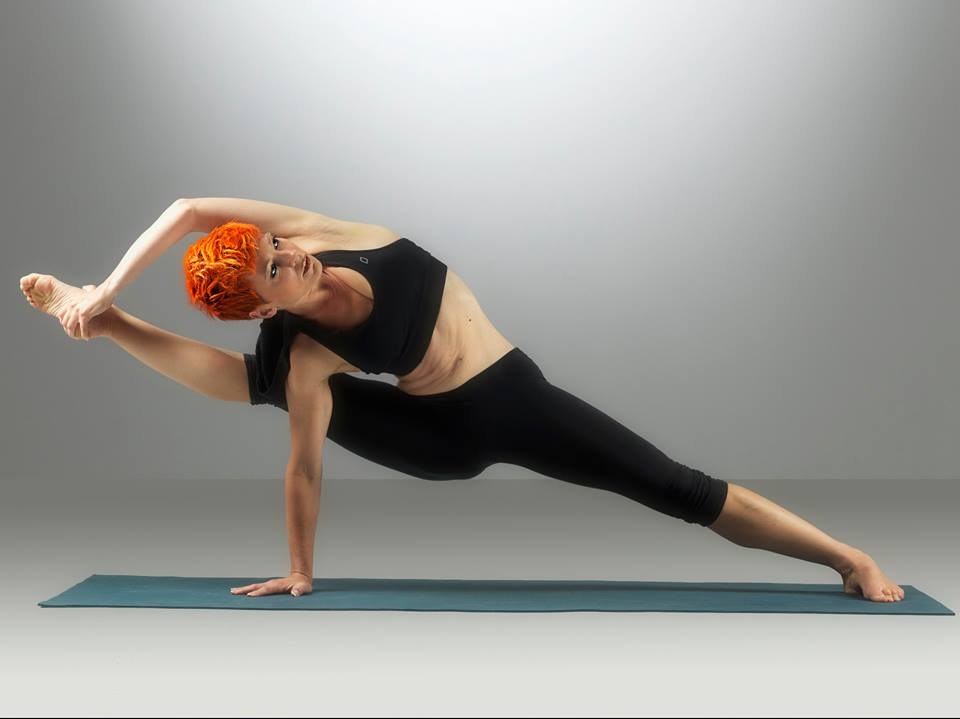
Want to stretch and breath? Then check out our list of drop-in yoga classes for tourists, visitors and the uncommitted. We go to Nataraja Studio, by Dragon Bridge, and here's a story about it.
Prefer to have someone else stretch you? The check out the totally legit massages you can get from Sense Wellness - either in one of their spas or in you home, office or hotel. (And - to repeat - these are legit and non-sexual in nature)
There are some golf courses near Ljubljana, but even ones further away are not far, as seen in our list of all the golf courses in Slovenia.
![]()
Photo: maxpixel.net, public domain
Daytrips
Most of Slovenia is only a few hours from Ljubljana, and you can easily visit Lake Bled, Lipica Stud Farm, Postojna Cave, Predjama Castle, the coast and other locations, while if you'd like to take a photo of from that bench in Bled, then you can learn how to get there here. If you’re looking for something more ambitious, then check out our recent guide to the 17 members of the Association of Historical Towns of Slovenia. We've also written guides on spending from four to 48 hours in Bled and Piran.
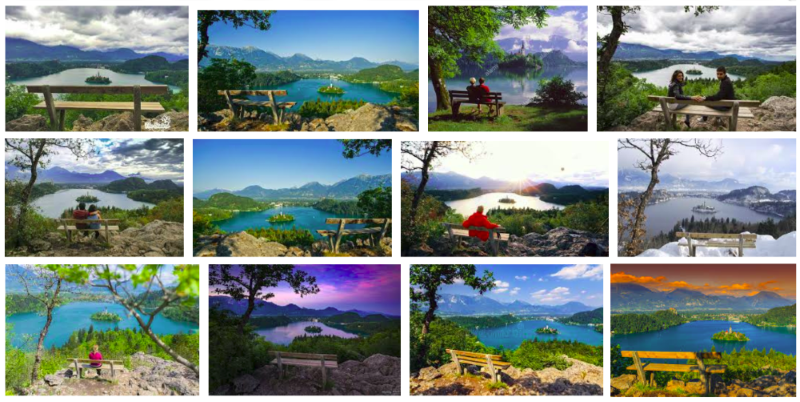
Photo: Google Image Search
Getting around
If you want to get a Ljubljana Tourist Card, which gives you travel on the city buses and entry to a lot of attractions, then you can read more about that here, and if you want to use the bike share system, as useful for visitors as it is for residents, then you can learn more by clicking this. Visitors with reduced mobility will be pleased to find that downtown Ljubljana is generally rated as good with regard to accessibility, and that there’s a free, city-sponsored app called Ljubljana by Wheelchair highlighting cafés, attractions and so on with ramps, disabled bathrooms and Eurokey facilities, which you can read about and download here. Manual wheelchair users can also borrow, for free, an attachment that will motorise their equipment, as reported here.
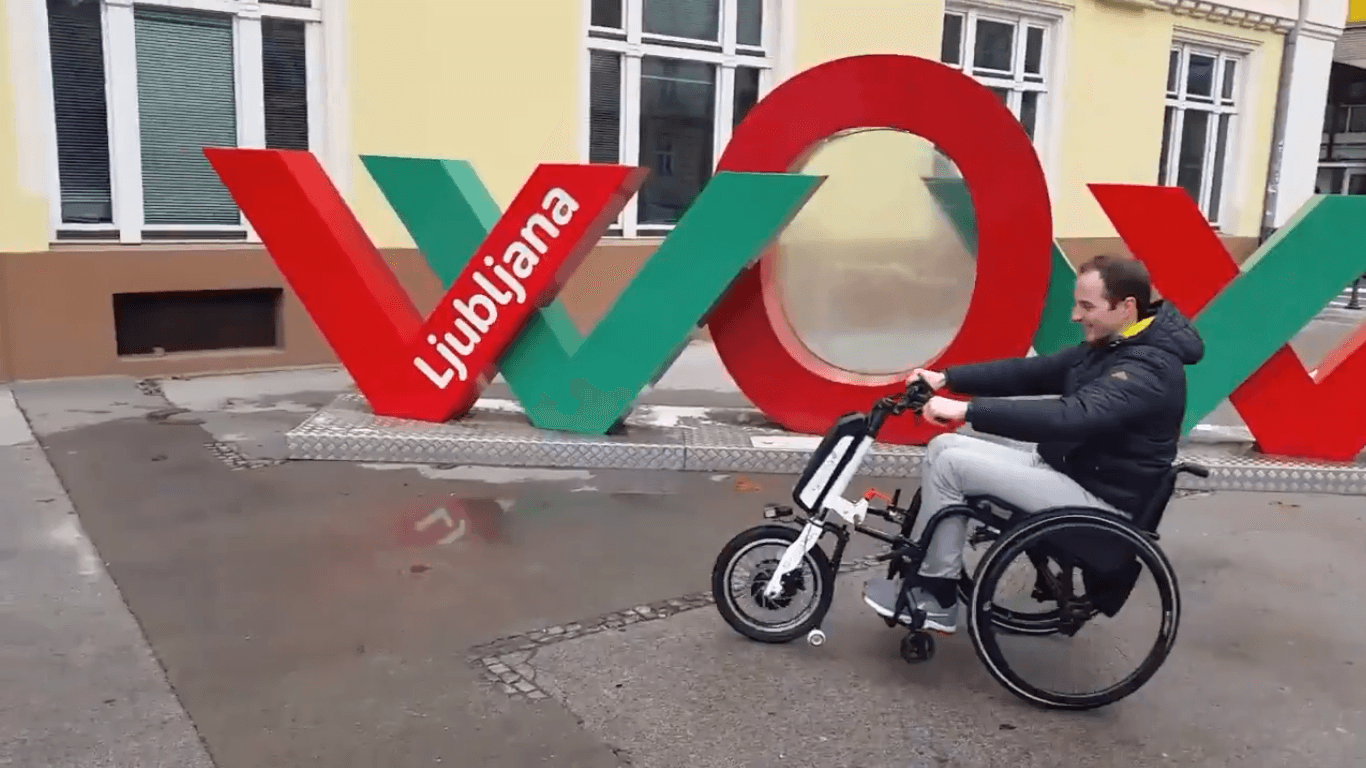
Screenshot from a Twitter video
If you’re driving into town and don’t know where to park, our guide to how to park in Ljubljana is here.
Emergencies
Ljubljana is a small and relatively safe city, but if need to contact the police then there’s a special number for foreigners, and that’s 113.
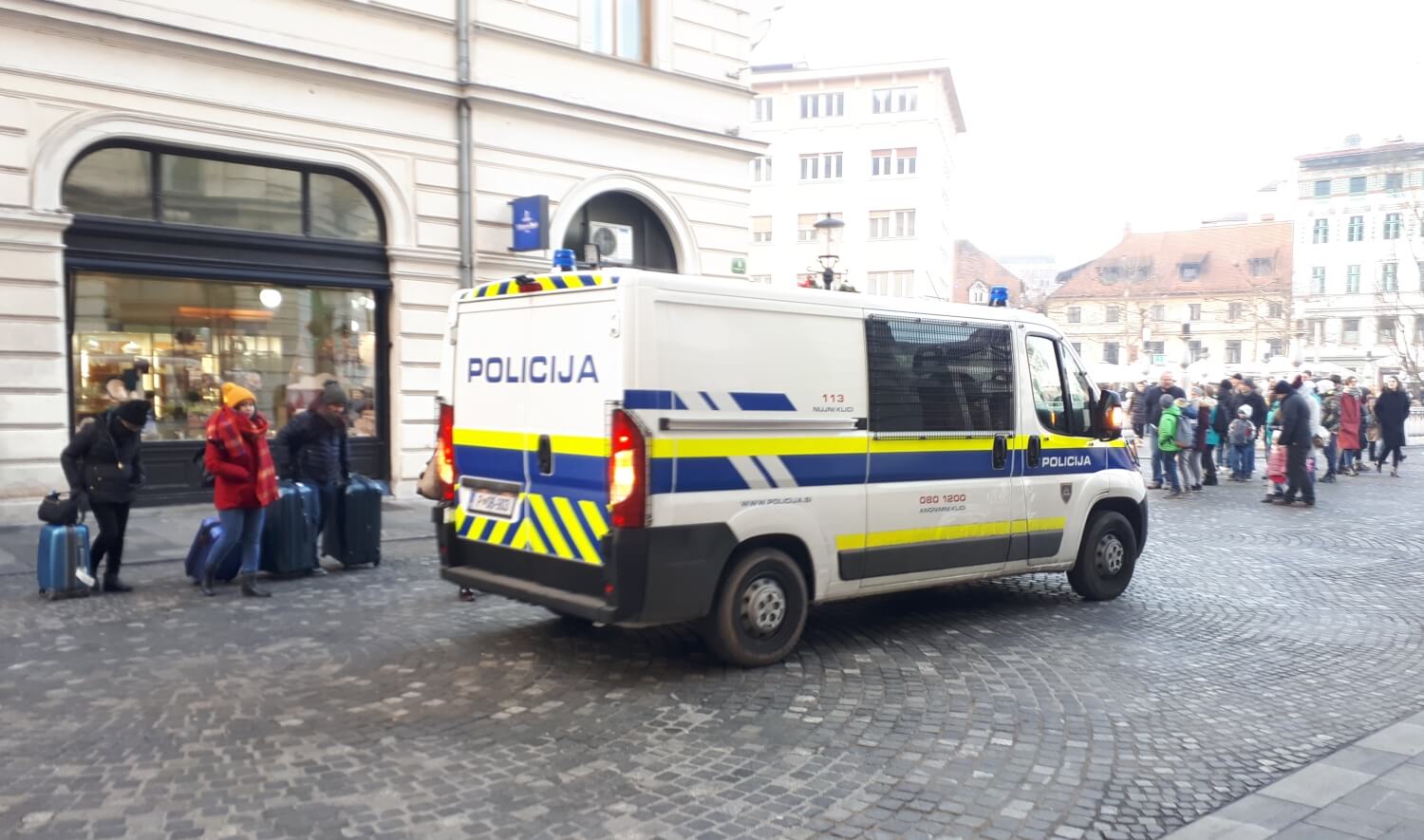
Photo: JL Flanner
There aren't many places to eat after midnight, and most of them are by the train station, as reported here.
Want / need cigarettes but the stores have closed? Here's an incomplete list of bars downtown that will satisfy your craving for the demon weed. While if you’re having trouble with the ATMs then here’s a guide to the Slovene you’ll see on screen. If you get a hangover then find out where to get paracetamol (and prescription drugs) in Ljubljana here, while details on emergency birth control can be found here.
The covers and editorials from leading weeklies of the Left and Right for the work-week ending Friday, 16 August
Mladina: Slovenia missed opportunity to thrive on elderly care
STA, 16 August 2019 - The latest editorial in the left-wing magazine Mladina blames politicians for Slovenia missing the chance to make elderly care a business opportunity as a result of which the system is falling apart, while the initiative is being taken by foreign multinationals.
In a piece headlined Old Age is Business, editor-in-chief Grega Repovž recalls how a decade ago Mladina proposed Slovenia take up the business called old age, turning care for a quality life of an ageing population into a whole new industry.
"That we should have started building adjusted housing developments, created a supply and care sector, developed specialised hospital services and healthcare centres. This way we would have created a whole new business and job sector, which unlike tourism lasts throughout the year and not just a few summer months."
Repovž argues that even less qualified workers could find jobs in such a sector, which would create high value added and provide a boost to the architecture and construction business as the country could become a specialist in construction for the elderly, a sizeable, active and financially strong population, especially in places like Germany or Austria.
He says that Slovenia has plenty of lovely spots where residential estates for senior citizens could be built, giving an impetus to the services industry catering for a "very agile population, incredibly inquisitive and brave".
Instead, Slovenia is a country in which 25,000 people are waiting for a room in a pension home, while nurses and carers are leaving for better paid jobs abroad, poor pensioners are leaving for pension homes in Croatia and foreign multinationals are building pension homes in Slovenia.
"This is because our politicians are ignorant, tending their own little garden patch and incapable of a single ambitious act outside their safe zone of the existing (...)
"Slovenia has done nothing in the field for more than 20 years. The last pension home was erected by the state 15 years ago, which piece of information is horrifying, but telling."
Demokracija: Worried about social surveillance
STA, 14 August 2019 - Governments in Western democracies, including Slovenia's government and NGOs, would be happy to legislate the ghastly Chinese system of social surveillance termed Social Credit System, the right-wing magazine Demokracija argues in its latest commentary.
It says totalitarianisms have always wanted to have total control of their citizens' lives, which was technically impossible until the end of the 20th century.
But this has changed with the dawn of artificial intelligence, surveillance cameras and social networks, editor-in-chief Jože Biščak says on Wednesday.
"Although the situation in Europe is not as bad as in China yet, there are signs that citizens are being pigeonholed to bad and good ones."
The Slovenian government rewards, that is pays with taxpayer money, those NGOs which spy on co-citizens and report on them, says the weekly.
It notes the Faculty of Social Sciences is already tasked with reporting on people on social media, and recalls that those taking part in the ZLOvenija portal during the 2015 migration crisis were labelled racists, Nazis and xenophobes.
Biščak also takes issue with the recent broad interpretation of hate speech by Supreme Court judges, saying it is worrying, whereas the left welcomed it as a step in the right direction.
"What is missing is a public government system which will record heretic deviations of free-thinking individuals and undermine the bad ones in everyday life.
"The Chinese reality is not far from Slovenia any more, with a public and government-approved black list of disobedient and too freedom-loving people as state enemies already knocking on the door."
If such surveilance is put in place, "there will be no place to hide, even the panic room will be under surveillance", Biščak says under the headline Panic Room, wondering whether "we will let this happen".
Other articles in this series can be found here
STA, 14 August 2019 - Slovenia is observing 100 years since its northeastern-most region of Prekmurje was united with the rest of the nation after World War I and the collapse of the Austro-Hungarian Empire. Located east of the river Mura, Prekmurje was the only territory the Slovenian nation gained at the 1919 Paris Peace Conference.
For nearly a thousand years, Prekmurje was a part of the Kingdom of Hungary, while the remaining Slovenian lands were under Austrian rule.
When the Hapsburg family, the rulers of Austria, took over Hungary in the 16th century, Prekmurje still remained under the Hungarian part of the monarchy, separate from the rest of what is now Slovenia, the Mura etching out a sharp border between the lands up until after World War I.
The peace conference that followed World War I decided that Prekmurje become a part of the then Kingdom of Serbs, Croats and Slovenes on 17 August 1919.
Five days before the date, the royal military occupied the region, handing over the region to the kingdom's civil authorities on the date agreed at the peace talks.
The border between Hungary and the Kingdom of Serbs, Croats and Slovenes was drawn along a demarcation line proposed by Douglas W. Johnson, a cartographer teaching at Columbia University who was a member of the US delegation at the Paris Peace Conference.
He proposed that the border line run north of the Mura, based on statistics provided by Matija Slavič, a member of the Yugoslavian delegation at the conference.
The break-away of Prekmurje from Hungary would not have been possible without a strong national awareness of the people of Prekmurje and the region's well-nourished dialect, according to linguist Klaudija Sedlar, specialising in the region's cultural and historic heritage.
This national fight was also fought along religious lines, with Catholic priests playing a key role against aggressive assimilation launched by Hungary with the help of the Protestant Church in an attempt to preserve its western-most region.
Among other things, catholic priests from the region of Prlekija, just across the Mura, smuggled Slovenian books in barrels across the river in the 19th century, getting some 20,000 books to people living in very modest conditions but nurturing an impressive reading culture.
The Trianon Peace Treaty, which saw Hungary lose two thirds of its territory, also left a part of the Slovenian population in Hungary. A century later, the community living along the Raba river is in no mood to celebrate.
Although recognised as a national minority by Hungary, the community was cut off from its nation and forgotten by Hungary, Andrea Kovacs, the president of the Association of Slovenians in Hungary, has told the STA.
Overnight, the community found itself in a completely different situation, losing writers, teachers, priests, professors and clerks, as Hungarian clerks, teachers and other state staff were sent to the villages along the Raba, launching assimilation that continues today, she said.
"Although they were left to their own devices, our forefathers were very stubborn and this stubbornness helped that we still live in Monošter [Szentgotthard] and seven surrounding villages today," she said.
On the other hand, there was also a Hungarian community left on the Slovenian side of the border, which has consistently refused to celebrate Prekmurje Reunification Day.
This year, however, the minority's MP Ferenc Horvath has accepted the invitation of Slovenia's Prime Minister Marjan Šarec to be a part of a special state committee that prepared the celebrations for the centenary.
He also spoke openly about the sensitive aspects of the anniversary, underlining at the same time that Prekmurje must remain as diverse as it is today at least for the next 100 years.
Recognising that this is a sensitive issue for the Hungarian minority, those preparing the many celebrations have repeatedly said that the celebrations are not designed in opposition to anybody.
Just like a century ago, the biggest events will all take place in Beltinci, a small town south of the region's biggest city, Murska Sobota.
On 17 August 1919, after Sunday mass, the square outside the Beltinci church became the venue of a massive rally that saw more than 20,000 people celebrate the region's unification with the Slovenian nation.
The main event will be the state ceremony on Saturday, which is to be addressed by the prime minister. President Borut Pahor is to address a ceremony organised by the Municipality of Beltinci the night before, as the community has made the reunification also its municipal holiday.
Moreover, the Archbishop of Ljubljana Stanislav Zore will offer mass in Beltinci on Saturday. The mass will likely be the most multicultural event of all, featuring representatives of the Protestant Church and the Hungarian Catholic Church, among others.
On Monday, a new square named after the region will be inaugurated in Ljubljana, while the central bank has issued collectable coins marking the centenary last week.
More than 77,000 people live in Prekmurje on a surface area of nearly 950 square kilometres of what is mainly flat agricultural land dotted with villages.
However, the region's population seems to be shrinking. While the entire country has seen a decrease in the number of newborns, elsewhere the negative population trend has been kept at bay by people moving to Slovenia.
However, Prekmurje, often considered one of the least developed parts of the country, does not make for an attractive destination for many. Statistics show that just over 280 people moved to the region in 2017, while nearly 19,000 people moved to Slovenia that year.
Thus, before the holiday, its native MP Jožef Horvat, proposed to Šarec that a strategic development partnership be set up to create an attractive business environment in which the young would like to work and set up businesses.
Check the date at the top of the page, and you can find all the "morning headlines" stories here. You can also ollow us on Facebook and get all the news in your feed.
A schedule of all the main events involving Slovenia this week can be found here
Visiting Ljubljana? Check out what's on this week, while all our stories on Slovenia, from newest to oldest, are here
This summary is provided by the STA:
Ministry rejects arbitration-related statements by new Croatian FM
LJUBLJANA - The Slovenian Foreign Ministry responded to the recent statements in the media by new Croatian Foreign Minister Goran Grlić Radman related to the border arbitration between the countries. The ministry said that the minister had uttered "several non-truths", which Slovenia resolutely rejected. Among other things, Grlić Radman said that Cerar, while still the PM, had almost accepted the Croatian offer in December 2017 that the border issue be resolved bilaterally, with a "protocol in six points", just as he was visiting Zagreb. The Slovenian ministry said that Slovenia was "in intensive, discreet dialogue after the final arbitration decision was announced in order to find a solution which would take into account the arbitration decision while being acceptable for both sides... It turned out in the talks that Croatia wants substantial changes in the course of the border in its favour. This is why an agreement was not reached."
Illegal border crossings peaked in July since refugee crisis
LJUBLJANA - July saw the highest number of illegal crossings of the state border in a month since the 2016 migration wave - more than 1,700. During the first seven months of this year the upward trend in such crossings was steeper than last year, according to police. In July a total of 1,740 illegal crossings were detected, while the police recorded 7,415 in the first seven months, mostly apprehending illegal migrants from Pakistan, Algeria and Afghanistan.
Tanja Strniša appointed new ambassador to Czech Republic
LJUBLJANA - President Borut Pahor has appointed Agriculture Ministry State Secretary Tanja Strniša Slovenia's new ambassador to the Czech Republic, shows the latest issue of the National Gazette. Strniša, who was appointed by Pahor on Monday, will replace Leon Marc as the head of the Slovenian Embassy in Prague. As a long-serving state secretary at the Ministry of Agriculture from the Social Democrats (SD), Strniša belongs to the quota of political ambassadors. The 56-year-old is not without diplomatic experience, though, as she worked at the Slovenian Embassy in Prague between September 2008 and July 2009.
Average net wage down 0.8% in June
LJUBLJANA - The average wage in Slovenia in June was EUR 1,717.78 gross or EUR 1,107.96 net, with the former being down by 0.9% in real terms compared to May and the latter by 0.8%, the Statistics Office reported. The average net wage in June was up by 0.3% in the public sector, while it was down by 1% in the private sector. In the first half of the year, the average gross wage in Slovenia was up 2.8% in real terms and by 4.3% nominally. The average net wage was up nominally by 3.6% and by 2.1% in real terms. The average net wage in the January-June period was up both in the public sector and private sector, by 4.5% and 3.3%, respectively.
Almost 13,500 sign petition against bear and wolf culling
LJUBLJANA - Amid escalating tensions over action in response to a growing number of wolf attacks on farm animals in Slovenia, 13,462 people have signed a petition urging against the planned culling of bears and wolves. The petition, initiated by the animal rights group AniMa, was handed to Environment Minister Simon Zajc. The initiator of the petition, Andreja Galinec, reported with disappointment after the meeting that "we failed to prevent the culling". According to the ministry, Zajc said the emergency act on culling was "needed at this moment to get the numbers back to a level that is also favourable for the local human population".
Tonin says NSi centrist party surrounded by socialists and nationalists
LJUBLJANA - New Slovenia (NSi) head Matej Tonin has responded to criticism of the announced repositioning of the centre-right opposition party to the centre of the political spectrum by saying it would be hard for the NSi to be anything else, "since those left of us are socialists and those to the right nationalists and global warming deniers". Tonin wrote on the NSi's website that the attacks had come immediately both from the left and the right. In an allusion to some of the senior members of the right-wing Democrats (SDS), Tonin wrote that the loudest criticism was coming "from those, who executed drastic political U-turns during their political lives ... former fervent Marxists who are now global warming deniers".
Gorenje looking for 100 new workers in production
VELENJE - Home appliances maker Gorenje, which terminated the contracts of 60 back office workers as part of reorganisation last month, has told the STA it was looking for about 100 new workers in production to meet increased demand. Gorenje representative Denis Oštir said that the new workers would start already in September, would get fixed-term contracts and were needed in all of the company's production facilities in Velenje, mostly in the production of washing machines and driers.
Compulsory car insurance premiums on the rise
LJUBLJANA - The number of compulsory car insurance policies has been showing an upward trend in the past few years due to the improved economic situation and the growth of the number of registered vehicles, with revenue from premiums being on the rise for the past three years. Slovenian insurers dealing in compulsory car insurance sold 1,914.134 such policies last year, a 4.6% increase compared to the previous year and a record number so far, according to the Slovenian Insurance Association. Eight Slovenian insurers were selling third-party liability insurance policies in 2018. They sold a total of EUR 244.2 million premiums, up 6.6% on 2017. Stronger competition in the insurance market has resulted in lower premiums. Despite the upward trend of sold policies, the premiums have been getting cheaper in the past decade - by 2.8% per year on average.
Tourism takes toll on Slovenia's famous lake, algae multiply
BLED - The National Institute of Public Health (NIPH) has been notified that golden-brown algae have multiplied at Lake Bled. Bathers should therefore avoid water activities where the algae are visibly present and take a shower after bathing. Špela Remec Rekar from the Slovenian Environment Agency, who monitors the state of Lake Bled, pointed out that the ecological state of the lake, which was always in good or solid condition, is worsening. The expansion of tourism and an increase in the number of fishermen and bathers are the reason for this.
If you're learning Slovenian then you can find all our dual texts here
What follows is a weekly review of events involving Slovenia, as prepared by the STA.
If you’d like to keep up on the daily headlines then follow those here, or get all our stories in your feed on Facebook.
FRIDAY, 9 August
LJUBLJANA - National councillor Branko Tomažič filed criminal complainants against Environment Minister Simon Zajc and Prime Minister Marjan Šarec, arguing their inaction in the face of bear and wolf attacks on farm animals. Action was also urged by Human Rights Ombudsman Peter Svetina. Šarec's office denied the charge, saying the government was actively engaged in tackling the issue.
LJUBLJANA - Fresh statistics showed Slovenia's merchandise trade with the rest of the world growing apace in the first half of the year. Exports increased by 9.2% year-on-year to EUR 16.83 billion as imports rose by 11.2% to EUR 16.78 billion, creating a surplus of EUR 48 million. Meanwhile, the country's industrial output expanded by 3.7% y/y, the slowest pace in six years.
LJUBLJANA - The newspaper Dnevnik reported that retailer Mercator had initiated the sale of 13 shopping centres, one in Slovenia and twelve in Bosnia-Herzegovina, Croatia and Serbia as part of its strategy to reduce debt, which stood at roughly EUR 667 million at the end of March.
LJUBLJANA - The Slovenian version of the #MeToo campaign presented findings after collecting more than 150 anonymous testimonies from victims of sexual assault or harassment since March 2018. These as a rule knew the perpetrator and most were abused as minors. When speaking out about the abuse, the victims were usually met with silence.
SATURDAY, 10 August
VELIKE LAŠČE - Several hundred farmers gathered in protest at a lack of action in the face of ever more frequent wolf attacks on farm animals. They demanded a significant decrease in the country's wolf population, which they want restricted to fenced-in reserves in state-owned forests. The rally, staged by the Farmers' Trade Union, also urged Environment Minister Simon Zajc to resign, a demand that Zajc turned down as unwarranted. The protest coincided with a new incident in which wolves killed ten sheep in the Kobarid area in the west.
SUNDAY, 11 August
LJUBLJANA - The Government Office for Slovenians Abroad has drawn up a proposal to repatriate persons of Slovenian descent from Venezuela, which is expected to be debated by the government after summer recess. There are an estimated 1,000 people of Slovenian descent in Venezuela, 47 have made requests for repatriation after the latest crisis in the country.
ODRANCI - The Swiss industrial company Limec Solution opened a plant in Odranci in north-eastern Slovenia, which is expected to employ between 150 and 200 people in three to five years. The operation, Limec CNC will produce 90% of the products which are now made in Switzerland, Germany and Austria.
MONDAY, 12 August
LJUBLJANA - Slovenia's youth organisations took the opportunity of International Youth Day to highlight housing as the key problem faced by young people. They criticised a lack of action on the part of the government, saying the flawed housing policy, coupled with precarious and low-paying jobs, made it hard for them to become independent. The young continue to face problems accessing the labour market, which is why the youth trade union Mladi Plus urged improving the apprenticeship and mentorship systems.
LJUBLJANA - A poll run by the newspaper Delo showed Prime Minister Marjan Šarec's LMŠ party extending its lead ahead of the opposition Democrats (SDS) after gaining 2.2 percentage points from the month before to 16.8%, as the SDS stayed almost level at 14.2%. The coalition SocDems lost 0.6 points to 7.2%, whereas the opposition New Slovenia (NSi) gained 1.4 points to 6.7% to come ahead of the Left (6.5%).
LJUBLJANA - More than 60 real estate agencies asked the Constitutional Court to review legislative amendments that limit commission fees for rentals and other costs charged by real estate agencies on their clients. They argue the provisions encroache on the right to free enterprise and the right to property, thus contravening the European Convention on Human Rights as well as EU law.
TUESDAY, 13 August
LJUBLJANA - The Foreign Ministry confirmed Croatian media reports about Minister Miro Cerar having held an informal meeting with Croatia's new Foreign Minister Goran Grlić Radman while on holiday in Croatia. The ministry said the pair would hold their first official meeting on the sidelines of the EU foreign affairs ministerial in Helsinki on 29 and 30 August.
LJUBLJANA/AJDOVŠČINA - Environment Minister Simon Zajc announced changes to provisions governing emergency culling of wolves to facilitate action in the wake of a spate of wolf attacks on farm animals and criticism by farmers that the emergency law to cull bears and wolves was not producing results. On the same day a she-bear with a cub attacked a hunter in the woods in the south-west in what was a second bear attack on people this year. The hunter sustained light injuries.
LJUBLJANA - The University of Ljubljana and URI Soča Rehabilitation Institute signed agreements with Japan's Fujita Health University and Toyota Motor Corporation to cooperate on development of robotised devices to be used in rehabilitation of patients after stroke or injuries.
HRASTOVLJE - Nearly two months after almost 11,000 litres of kerosene leaked from a derailed cargo train near the village of Hrastovlje in the south-west, repair works were completed as one of the country's busiest routes re-opened after being shut for four days to replace 150 metres of tracks. In total, the repair works cost EUR 1.5 million, on top of a loss of more than EUR 1 million to the national railway company for each day the track was fully closed.
LJUBLJANA - The opposition Democrats (SDS) mounted their fifth attempt at getting parliament to put public funding of private primary schools on a par with that of public schools, submitting a bill to implement a 2014 Constitutional Court ruling ordering full funding of private primaries teaching state-approved curricula. These currently get 85% of their funds from the government.
LJUBLJANA - A report by the central bank showed incoming foreign direct investment in Slovenia more than doubled in the first half of 2019 to EUR 614.4 million.
TRONDHEIM, Norway - Slovenia's football champions Maribor failed to advance to the last round of qualifications for the UEFA Champions League after losing to Norway's Rosenborg 2:6 on aggregate. Maribor played in the Champions League in 1999/2000, 2014/15 and 2017/2018.
WEDNESDAY, 14 August
LJUBLJANA - The potential for economic cooperation ranked prominently as Taro Kono visited Slovenia as the first Japanese foreign minister for talks with his counterpart Miro Cerar and President Borut Pahor. Cerar and Kono also called for respect for the rule of law and arbitration decisions, including with regard to the Adriatic and the South China Sea. The pair also visited the Yaskawa robot factory in Kočevje.
LJUBLJANA - The government dismissed Damir Topolko as director of the Infrastructure Agency in the wake of a scandal over the 2017 botched tender for a scale model of a new rail track planned between Koper and Divača. Monika Pintar Mesarič, a Finance Ministry employee, was named as acting director as of 1 September.
LJUBLJANA - More than 25 years after the National Assembly passed legislation that ordered the establishment of provinces and after several failed attempts, a task force established in May 2019 presented a draft bill to divide Slovenia into 11 provinces centred around major cities.
RIMSKE TOPLICE - The engine of an international freight train and one of the rail cars derailed at the Rimske Toplice train station in a second such incident in just over a week. The railway line between Zidani Most and Celje, a major link for international passenger and cargo traffic, reopened the next day. It remains unclear what caused the derailment.
LJUBLJANA - Slovenia generated EUR 1.16 billion in revenue from incoming tourism in the first half of the year, an increase of 4.8% compared to the same period a year ago, data from the central bank showed. In June alone, receipts from incoming tourism rose by 9.3% year-on-year to EUR 243 million.
LJUBLJANA - The value of construction works in Slovenia rose by 14.4% in the first six months of 2019 year-on-year, show data released by the Statistics Office.
THURSDAY, 15 August
BREZJE - Thousands of Catholic pilgrims gathered at religious shrines devoted to the Virgin Mary across Slovenia to celebrate her assumption into heaven. The largest crowd converged outside the Basilica of Mary Help of Christians at Brezje for mass celebrated by Archbishop of Ljubljana Stanislav Zore.
TOKYO, Hachioji - Slovenia swept the women's lead discipline event at the IFSC Climbing World Championships with Janja Garnbret taking another gold and Mia Krampl silver. This is the second gold medal for Garnbret at the championships after she defended the title of bouldering world champion on 13 August, and her fifth world championship gold medal overall.
STA, 16 August 2019 - July saw the highest number of illegal crossings of the state border in a month since the 2016 migration wave - more than 1,700. During the first seven months of this year the upward trend in such crossings was steeper than last year, according to police.
In July a total of 1,740 illegal crossings were detected, while the police recorded 7,415 in the first seven months, mostly apprehending illegal migrants from Pakistan, Algeria and Afghanistan.
Related: Foreign Nationals in Slovenia, by Country, Region & Continent
Below you will find the charts with the numbers of illegal border crossings, including the year, citizenship, period, police department and the number of persons handed over to Slovenia from foreign authorities or vice versa.
The charts also feature the number of international protection requests as well as the number of approved requests and the number of asylum seekers by their accommodation so far.
Number of illegal border crossings in the first half of the year by year
year number of crossings ------------------ 2010 339 2011 419 2012 399 2013 660 2014 384 2015 181 2016 273 2017 754 2018 3635 2019* 5568 *up to 31 July Source: Police
Number of illegal border crossings in the first seven months of 2018 and 2019 by citizenship
citizenship number of crossings
2018 2019
------------------------------------
Pakistan 1446 1705
Algeria 643 1153
Afghanistan 482 811
Morocco 250 592
Turkey 106 371
Bangladesh 22 521
Iraq 228 364
Iran 271 368
Syria 432 318
Tunisia 60 141
other 819 1071
-----------------------------------
total 4759 7415
Source: Police
Number of processed illegal border crossings in the first seven months of 2018 and 2019 by police department
department number of crossings
2018 2019
----------------------------------------
Koper 2032 2807
Novo Mesto 1978 1918
Ljubljana 225 1556
Maribor 355 676
Celje 52 134
Murska Sobota 98 176
other 18 148
Source: Police
Number of illegal border crossings and international protection requests in 2018 and in the first seven months of 2019 by month
number of crossings number of requests month 2018 2019 2018 2019 --------------------------------------------------- January 246 319 172 205 February 210 328 223 216 March 207 1079 129 356 April 644 1381 274 334 May 1286 1298 365 404 June 1040 1270 267 287 July 1114 1740 287 387 August 1152 381 September 999 256 October 1270 201 November 717 170 December 357 150 -------------------------------------------------- total 1-6 3633 7415 1430 2189 Source: Interior Ministry, Police
Number of persons returned to the Slovenian authorities and to foreign authorities in the first seven months of 2018 and 2019
returned to Slovenian returned to foreign authorities authorities country 2018 2019 2018 2019 --------------------------------------------------------------- Italy 193 184 39 55 Austria 15 53 8 8 Croatia 6 15 1715 4827 Hungary 12 1 2 0 airports 94 163 20 18 --------------------------------------------------------------- total 320 416 1784 4908 Source: Police
Number of international protection requests in 2018 and in the first half of 2019 as well as their status
status number
2018 2019
---------------------------------------------------
total number of requests 2875 1802
requests to repeat the procedure 40 13
repeated procedures 27 30
closed cases 2886 1762
approved status 102 40
rejected applications 135 54
halting of procedure 2372 1535
discarded applications 277 133
resettlement 40 0
relocation 21 0
Source: Interior Ministry
Number of asylum seekers and persons with international protection and their accommodation up to today
Asylum seekers
accommodation number ----------------------------------------------- Asylum Centre 182 Kotnikova Street, Ljubljana 79 Logatec 23 dispersed 33 other 29 ------------------------------------------------ total 346
Persons with international protection
accommodation number ----------------------------------------------- Ljubljana Integration House 0 Maribor Integration House 25 Government-approved flats 18 Asylum Centre 1 Kotnikova Street, Ljubljana 1 Logatec 0 Student homes 14 Private accommodation 506 abroad 115 ----------------------------------------------- total 680 Source: The Government Office for the Support and Integration of Migrants
STA, 16 August 2019 - Amid escalating tensions over action in response to a growing number of wolf attacks on farm animals in Slovenia, 13,462 people have signed a petition urging against the planned culling of bears and wolves.
The petition, initiated by the animal rights group AniMa, was handed to Environment Minister Simon Zajc on Friday to "have the voice of reason heard when it comes to man's coexistence with bears and wolves".
The initiator of the petition, Andreja Galinec, reported with disappointment after the meeting that "we failed to prevent the culling".
"The answer we received was that the culling will not be halted," Nevenka Lukić Rojšek of AniMa said.
According to the ministry, Minster Zajc stressed at the meeting the the emergency act on culling was "addressing the burning issue of bear and wolf overpopulation and was needed at this moment to get the numbers back to a level that is also favourable for the local human population".
Zajc also announced he would inquire with his ministerial colleagues in the EU if there was a chance of one of the European countries accepting Slovenian bears and wolves.
He added the issue of overpopulation and management of bear and wolf populations needed to be removed from the realm of politics and returned to experts as soon as possible.
Danes mi je društvo AniMa izročilo peticijo proti odstrelu. Povedal sem jim, da je ta zdaj potreben! Po tem pa vztrajam: nujno mora o strokovnih vprašanjih odločati stroka in nikoli več politika. Posebej taka, ki ni za to vprašanje naredila nič, ko je imela priložnost! pic.twitter.com/rNAwnuU5C4
— Simon Zajc (@zajc_si) August 16, 2019
The group had proposed that the government immediately issue a moratorium on the emergency act regulating the culling and form a task force to analyse the state of affairs and find solutions that would not be dictated by political pressure.
Urging long-term measures to preserve wildlife and protect farm animals, the group says that Slovenia needs to preserve its population of wild animals as a key to preserve the balance of nature.
"Hunters have been interfering too much in this balance, and the price is now being paid by farmers, who a while ago demanded the culling of deer because of the damage to their crops," they say.
Arguing that there are also those among "the 22,000 armed people considered hunters" who use hunting as "a profitable business and cruel entertainment at the expense of animals", they believe that hunting for deer should be restricted and much better controlled, while subsidies for farm animal production in wolf and bear habitats should be made conditional on preventive measures.
"We urge the government not to be held hostage by a small interest group that demands violent solutions now, without considering long-term consequences. Slovenia is us too who disagree with the culling of bears and wolves, and there are many of us," the petitioners say.
The number of wolf attacks on farm animals has more than doubled this year over the same period in 2018, after an NGO successfully challenged in court the government's 2018 decree ordering the removal of 175 bears and 11 wolves from the wild.
Data from the Institute for Forests show that nearly 680 animals had been attacked by the end of July, but the number has increased since as new attacks are reported almost on a daily basis.
To tackle the situation, parliament passed a law in June ordering an emergency culling, but while hunters have killed 75 bears, the complex rules have prevented them from culling any wolves yet.
Following a protest by farmers on Saturday, changes have been agreed to facilitate the culling.
There are an estimated 1,000 bears and 80 wolves in the country. Most of the wolves live in 14 packs, while some live alone.
While there have been two attacks by bears on humans so far this year, Miha Krofel of the Ljubljana Biotechnical Faculty has told the STA that there is no confirmed case of a wolf hurting a human in Slovenia on record.
STA, 15 August 2019 - Slovenia's construction industry is seeing growth for the third year now. Nevertheless, it has still not returned to the levels before the crisis, while some indicators suggest that the growth trend could be reversed in the near future, finds a report by the Statistics Office.
Construction is one of the sectors that was hit hardest by the crisis ten years ago. While most of other sectors, such as industry, commerce and services, have already exceeded pre-crisis turnover, construction still lags far behind.
"After a significant fall in both the turnover and the number of employees and enterprises after 2008, growth was detected again in all three indicators after 2013, especially in 2017 and 2018," reads the statisticians' report.
While the number of construction enterprises has already reached the pre-crisis figures, with 19,220 such enterprises in 2018, the turnover and the number of employees still fall considerably short.
At the expense of the small number of workers, labour productivity increased and amounted to EUR 24,925 in 2018, exceeding the pre-crisis levels.
Construction companies generated a turnover of almost EUR 6 billion in 2018, which is almost 30% less than in 2008 and 34% more than in 2013. Almost half of the turnover was generated by specialized construction activities, 30% through construction of buildings and 21% by civil engineering.
There were 67,600 people working in the sector last year, compared 89,900 people a decade ago. 70% of the workers were Slovenian citizens and 30% foreigners. Most of the foreign workers came from Bosnia and Herzegovina, followed by those from Kosovo, North Macedonia, and Croatia.
Among the 19,220 construction enterprises registered in 2018, micro-enterprises with up to 10 employees prevailed, representing more than 90%. Compared to 2008 there were more than a half fewer medium-sized and large enterprises, however, in this period the number of parent enterprises doubled, which means that smaller enterprises which are interconnected prevail.
Wages in the sector had been increasing until 2011, but fell somewhat between 2011 and 2015, and after 2015 increased again. Average gross monthly pay was EUR 1,290 last year, which is 12% less than in 2008 and 23% less than the national average, despite a 20% growth compared to 2017.
Data on the number of the building permits and the construction confidence indicator suggest an impending decline. The number of building permits issued declined over the past three years and the trend continues in 2019 - in the first half of this year 10% fewer building permits were issued compared to the same period in 2018.
Only the number of residential building permits is somewhat increasing, whereas the number of non-residential building permits issued is falling. Between 2016 and 2018 the surface area of buildings for which building permits were issued increased (8%), as did the number of the apartments in those buildings (by more than 19%).
In the first six months of this year the construction confidence indicator was below the average of the previous year. Expectations for contracts and jobs peaked at the beginning of 2018, but then began to fall. The only exception was the indicator assured work in hand which in the first six months of 2019 was constantly above the average of the previous year.
As limiting factors to doing business, construction companies report in particular the shortage of skilled workers, fierce competition and high labour costs.
STA, 15 August 2019 - Bled Strategic Forum (BSF) secretary-general Peter Grk has told the STA that the stage is set at the lakeside resort for a new round of discussions on key topics, the focus this year being on sustainable development and climate change. Topping the list of high-profile guests are the Estonian president and the future head of the EU's diplomacy.
The central part of what is already the 14th iteration of Slovenia's top foreign policy event will be held on 2 and 3 September under the title (Re)Sources of (In)Stability.
Grk said that the ambition each year was to feature discussions as well as guests that could "capture the most important challenges and problems faced by the global community".
"Climate change is one of the biggest challenges for humanity in the coming years and decades. This is not a problem that will arise tomorrow. It is a challenge we are already facing today," he said.
The Bled meeting will aspire to go beyond only talking about climate change and also "try to look at how we need to change as a community in terms of sustainable development if the current level of development as well as norms and human rights are to be preserved".
"Its a fact that we live longer and better quality lives than in the past. But this comes at a price and the price is climate change," he said, also speaking of a crisis of the resources used so far - these are either harmful to the environment or running out.
"Also key is the question how to go about sustainable development to prevent it from deepening social differences and aggravating tensions. Sustainable development should become a responsibility for everybody, meaning that its benefits will be felt by everybody."
"We will examine this aspect from various viewpoints at BSF. We'll explore the responsibility of corporations, of government, as well as individuals, look at concepts, mechanisms and instruments that each factor in society needs to use for sustainable development to catch on or become integral. This will not happen unless we see an opportunity as opposed to danger in sustainable development," Grk said.
He noted that the BSF, traditionally held in early September, was a kind of prelude to the political autumn, both in Europe and wider.
"In this sense we will look at the situation in the EU, its future after the formation of the new European Commission. Given that we're marking the 70th anniversary of NATO, we'll examine the future challenges for transatlantic ties. A special panel will be dedicated to the issue of migration, which is also assuming a very important role in the context of sustainable development.
"As has become tradition, we'll also have a panel on the Western Balkans, which are facing particular challenges - the odds of EU enlargement should become fairly clear in the coming months. This is also important for Slovenia in the context of our presidency over the EU in 2021," Grk added.
Meanwhile, the business segment of the Bled forum will see a continuation, in cooperation with partners, of discussions on AI. A new aspect will be discussions on the introduction of new technologies, especially green technologies or the circular economy.
"This is one of the topics that gets a lot of lip service but then little gets done. And here we see a chance to raise this concept to a higher level and strengthen awarenesses about its importance in the context of sustainable development or the fight against climate change."
The Bleed meeting will again feature a number of exciting guests, with Grk even announcing "a few surprises". "The strategic forum will be held at a very important time, both for Europe and wider, so we expect it to be one of the more resounding forums in recent years," he said.
The list of the high-ranking foreign guests includes Estonian President Kersti Kaljulaid, UN High Commissioner for Human Rights Michelle Bachelet, as well at least ten foreign ministers, among them Spain's Josep Borrell, who is assuming the post of the EU's High Representative for Foreign Affairs and Security Policy.
Also, Finish Foreign Minister Pekka Haavisto will attend on behalf of the country presiding over the Council of the EU, while Julian King from Great Britain as Commissioner for Security Union will be representing the outgoing team of the European Commission.
Other high-profile guests who have confirmed attendance include Slovak Foreign Minister Miroslav Lajčak, who is serving as OSCE chairperson-in-office, and the current President of the UN General Assembly Fernanda Espinosa.
"This way we will have the entire multilateral global framework covered in Bled this year," Grk pointed out, while moreover highlighting the attendance of economist Jeffrey Sachs, coffee mogul Andrea Illy, Boston Consulting group head Martin Reeves, former Italian PM Enrico Letta and former Austrian Foreign Minister Karin Kneissl.
Grk praised cooperation with various partners, saying it was deepened and strengthened each year. "This comes to show that the strategic forum has evolved into an interesting and successful story and that we're trying to move certain things not only regionally but also in the European and perhaps global context".
He is convinced that the 14th iteration will provide findings that "Slovenian and European politics will be able to use in their future activities".
"The 15th anniversary is coming next year. This is already a number that shows we're slowly maturing as a forum. This is reflected both in the response of the international public as well as the guests, panellists, who confirm their participation fairly quickly each year or propose coming on their own," added the official.
There are no plans to grow the forum further. "We again expect around 1,000 to 1,200 participants from 60 to 80 countries," he said, while announcing the number of panel discussions would also not be increased.
"We are consciously not increasing these numbers, since we've come close to what is possible in terms of infrastructure at the event as well as in terms of logistical and technical demands in Bled. And in general, the ambition of the conference is not to become the biggest, but to have more quality," Grk said about the event, which is organised jointly by the Foreign Ministry and the Centre for European Perspective.
The format will also not change, with "the business segment remaining part of the BSF, just like the forum for the young which has become key for the partnership with the young and the promotion of their voice at the BSF". "I believe it is crucial that the young speak their mind on the challenges we face in the future," Grk said.
The budget for the conference also remains comparable to that in previous years, meaning around EUR 250,000. Most of the funding comes from partners and sponsors, Grk explained.
STA, 15 August 2019 - Thousands of Catholic pilgrims have gathered at religious shrines devoted to the Virgin Mary across Slovenia to celebrate her assumption into heaven (on 14 August). The largest crowd converged on Brezje for mass celebrated by Archbishop of Ljubljana Stanislav Zore, who spoke about the meaning of hope in his sermon.
"Man needs hope more than the famished need bread, more than the thirsty need water ... Once we've given up hope, the selfish me goes wild, seeing only oneself and ones needs," the archbishop told more than 5,500 believers congregated outside the Basilica of Mary Help of Christians.
The church in the subalpine village of Brezje (NW) is Slovenia's most popular pilgrimage site. It was reportedly the scene of a miraculous healing 156 years ago and several more after that.
In his sermon, the archbishop thanked all of those who aspire to make Slovenia as society open to life and those who make the effort so that all children should have equal opportunities to develop their potential, especially in education.
"I'd like to thank you for demanding justice for all; to everyone putting in their effort to have the Constitutional Court decision on funding of private schools implemented," he said.
The court mandated in 2014 that private primary schools teaching nationally-approved curricula should be granted full rather than 85% government funding just like public schools. However, the parliament has still not implemented the ruling.
The pilgrims have come to Brezje from all over the country as well as from abroad and many more are still expected there later in the day. According to the head of the Brezje pilgrimage office, Andreja Eržen Firšt, the shrine attracts more than 10,000 people every year and their numbers keep increasing.
The number of pilgrims at Brezje has been building up in the days ahead of Assumption Day, many of whom have come on foot. Every year Roma families from around Slovenia come to Brezje at this time of year with their pastoral leader to spend some time in retreat there. This year more 350 have come.
Many Slovenian churches and other shrines are dedicated to Mary and holidays celebrating the virgin are popular among believers. As a result, Slovenian bishops entrusted the Slovenian nation into her hands in 1992. Since that year, Assumption Day has been observed as public holiday in Slovenia.


